64 Sustainable Home Interior Decorating Ideas for a Stylish and Eco-Friendly Space
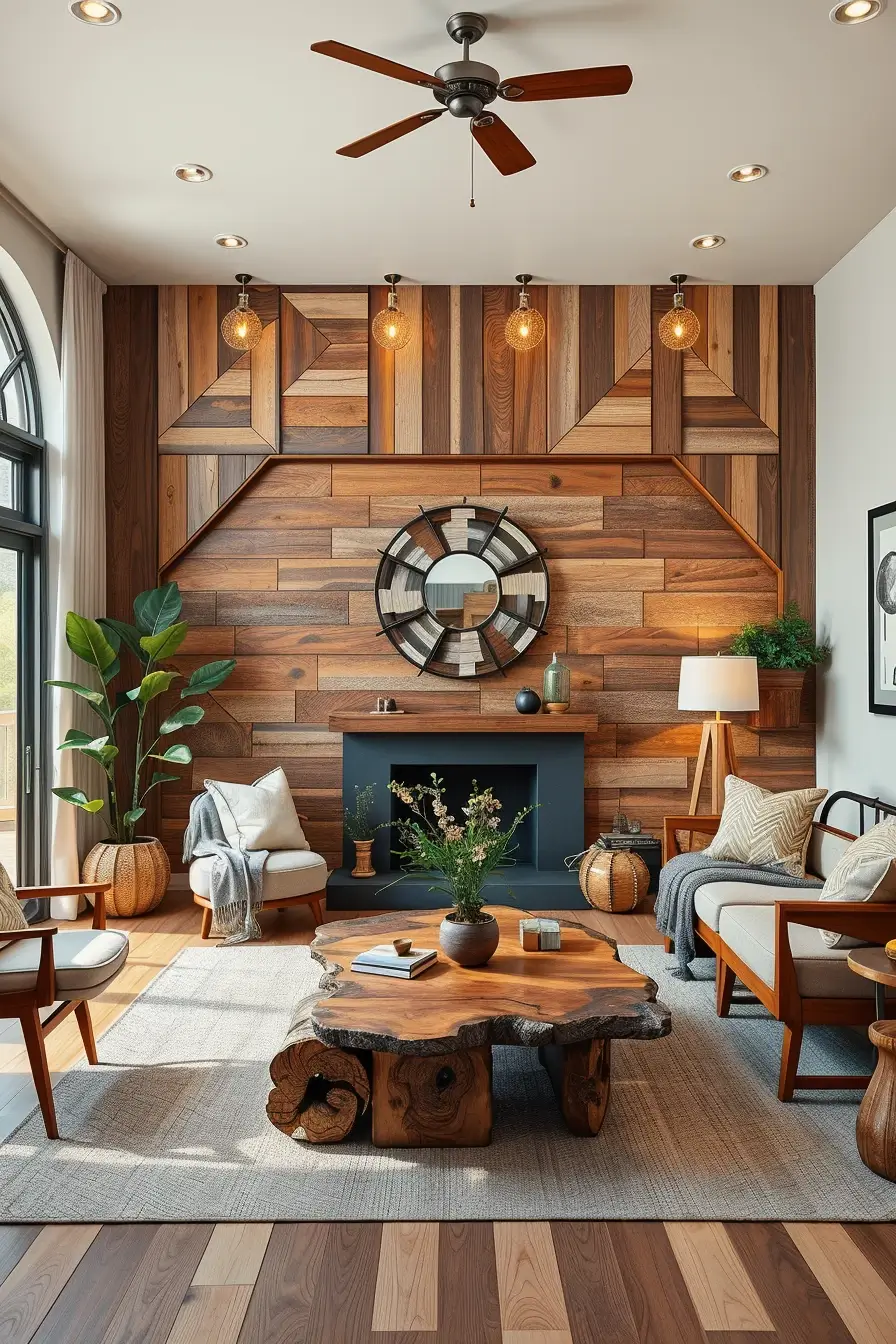
Sustainability in the home interior is not a fad anymore, but a way of life. Have you ever asked yourself how your daily choices in decorating can impact the environment? Everything can be done with a sustainability mindset, including the furniture you buy, the decor that fills your rooms, etc. I will present in this article practical and inspirational sustainable home interior decorating concepts that produce stylish, functional and eco-friendly spaces.
By the conclusion, you will find out how simple it is to combine aesthetics with environmental responsibility. It may be textiles, flooring or even bathroom fixtures, all design choices can make your home healthier and more sustainable.
Green Foundations: What You Can do to Make Your Home Greener
The first thing that I consider when I embark on any interior project with a sustainability orientation is the foundation. A house must be constructed or redesigned using materials that are eco-friendly and have a long service life. In my case, environmentally friendly materials are reclaimed materials, wood that is responsibly harvested and natural stone. These elements are not only structural, but they also offer a classic aesthetic that can be applied to any design style.
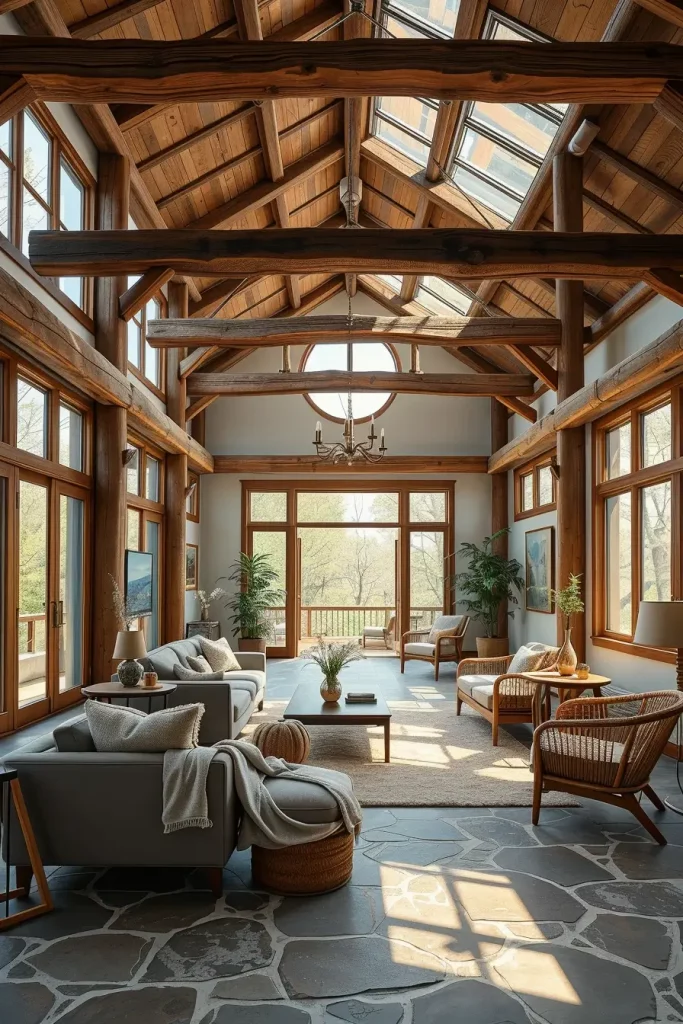
I tend to use non-toxic wall insulation, clay plasters, and lime-based finishes since they can control the humidity inside the building and are healthier options than synthetic products. Furniture items made of reclaimed wood or natural fibers also perfectly match such interiors and contribute to the theme of green foundation.
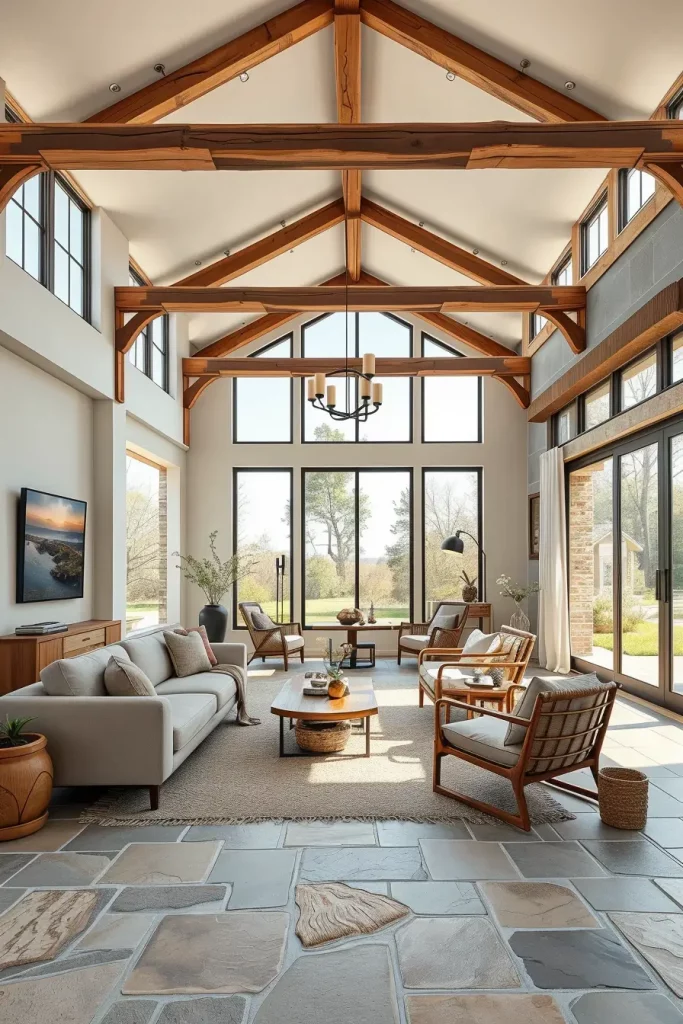
In my case, the U.S. Green Building Council suggests that LEED-certified materials should be used wherever feasible. This makes every decision highly sustainable. I have personally experienced the value of energy efficient homes that are aesthetically comfortable.
In this section, I would also highlight the need to incorporate natural light in basic design. Skylights, expansive windowing, and open floor plans minimize the need to rely on artificial lighting and create the effect of openness and spaciousness.
Choosing Sustainable Paints And Finishes For Walls
Whenever I am decorating interiors, I do not take a paint selection lightly. Traditional paints usually include VOCs which are harmful to indoor air quality and I would always suggest eco-friendly options. Sustainable paints are produced using plant-based binders, natural pigments and water-based solvents. Not only are they safer, but they also have beautiful finishes that compete with traditional finishes.
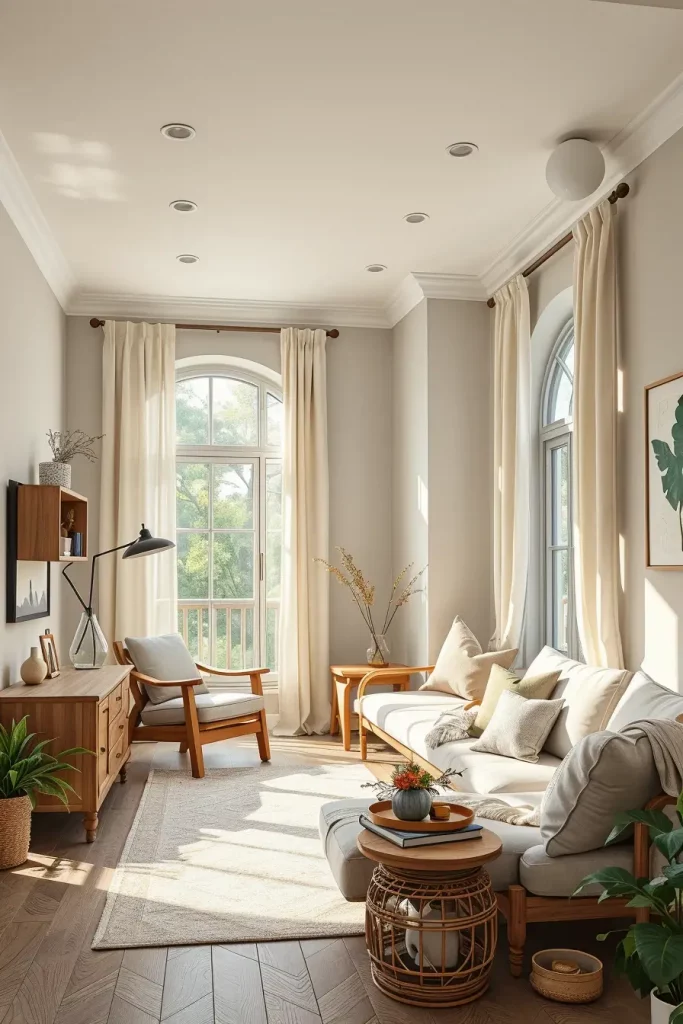
I apply low-VOC paints or natural lime washes on the walls which give the walls a natural and elegant feel. These two go perfectly well with recycled wood furniture and natural fabrics. A matte finish is particularly effective in the living rooms, and a washable eco-paint is convenient in the kitchen and bathroom.
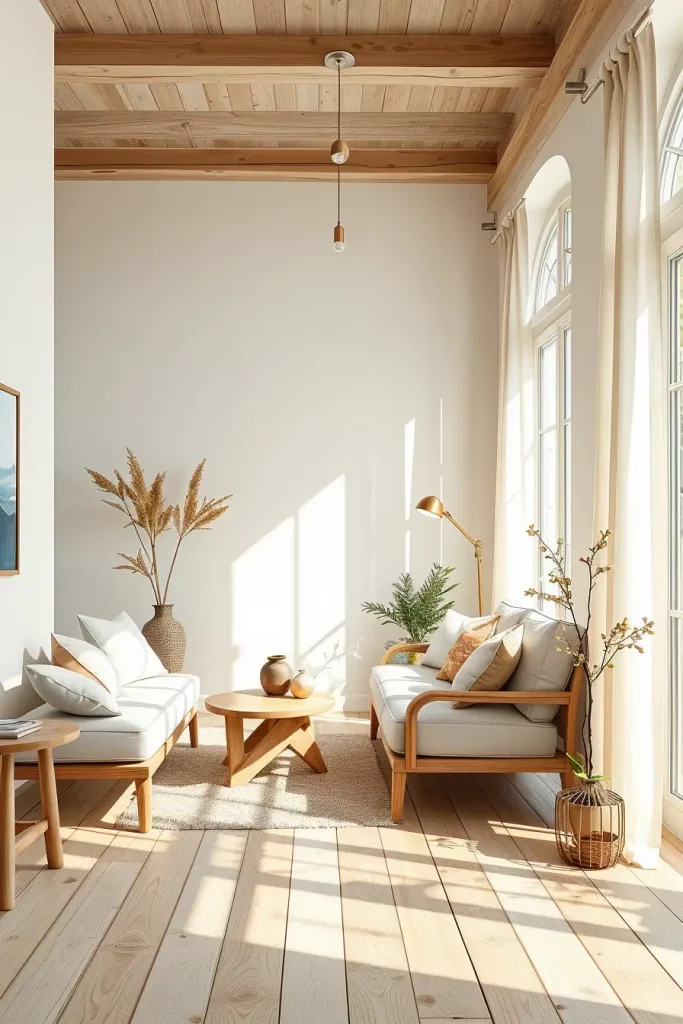
I have also read in Architectural Digest that when using eco-friendly paints, it is advisable to go with lighter colors because this will reflect natural light, therefore, eliminating the need to use artificial light. It is an intelligent design that is energy efficient.
Here, what is usually lacking is attention to finishes on woodwork and furniture. I use plant oils or natural waxes rather than synthetic varnishes at all times. They cover the surface but leave the material to breathe and prolong the life of furniture and decor.
Natural Flooring Options That Last A Lifetime
Flooring creates the mood of a sustainable house. I would choose natural floors like stone or terracotta tiles or hardwood that is harvested in a responsible manner. Such materials are durable and at the same time timeless, which means they will not require replacements very often.
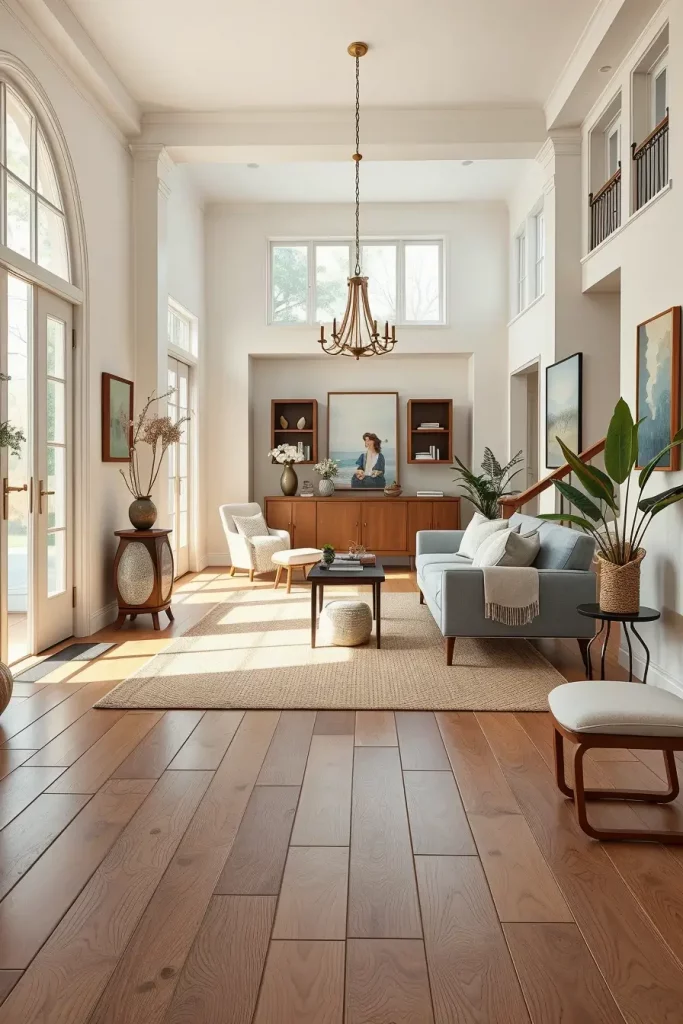
I also tend to use wide-plank oak floors with natural wool carpets in my projects. The wood is renewable, biodegradable and wool rugs are durable and simple to renew. Entryways and kitchen stone tiles are also a touch of class and maintenance is minimal.
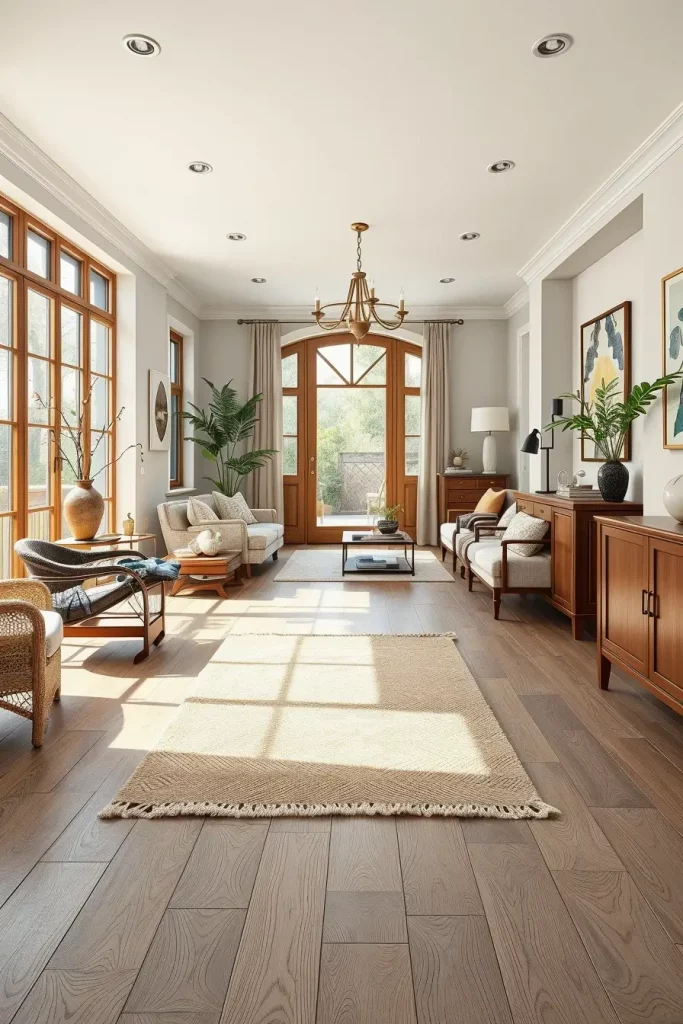
Elle Decor designers frequently suggest terrazzo that is composed of recycled stone or glass chips due to its environmentally friendly structure and beautiful appearance. I have observed how it has changed contemporary and traditional interiors.
Another point to include here is the significance of installation methods. Non-toxic adhesives and water-based finishes will make the floor environmentally friendly throughout its life.
Reclaimed Wood: Warm It Up Consciously
I am always attracted to reclaimed wood as it has a story. Every beam, plank, or panel has a history and does not allow perfectly good materials to go to landfills. I tend to use reclaimed wood as an accent wall, dining table or shelf. Its special texture and patina immediately make any place cozy.
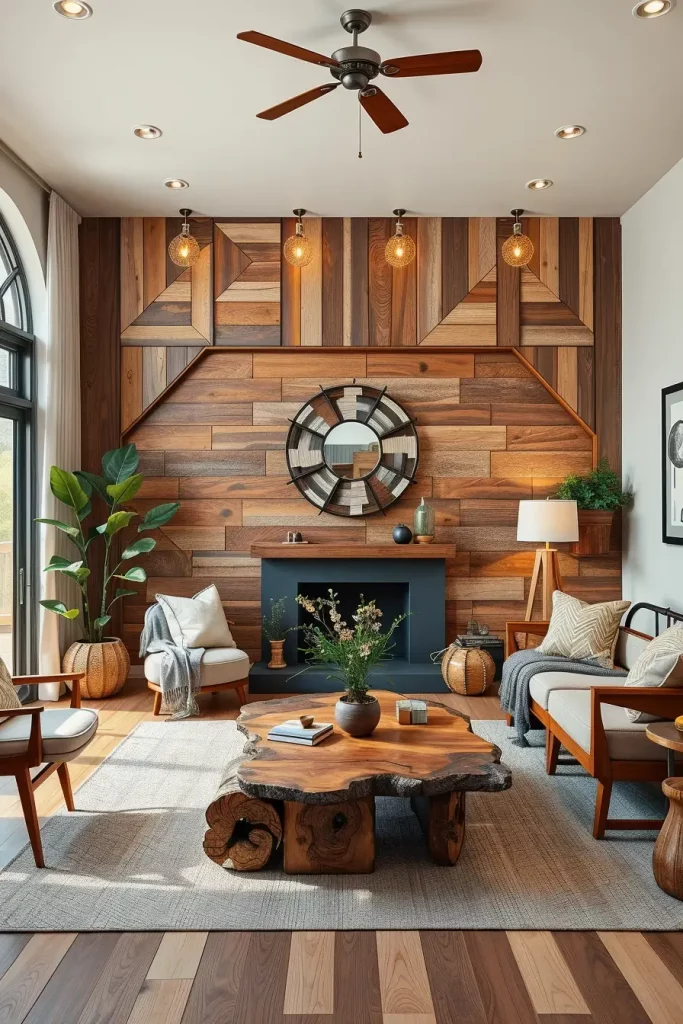
I prefer to use modern furniture when styling reclaimed wood to contrast with it. An example of a balance between rustic and modern would be a coffee table made of reclaimed wood with smooth and minimalist chairs. Not only is it visually attractive, but it also decreases the need of new timber that has just been harvested.
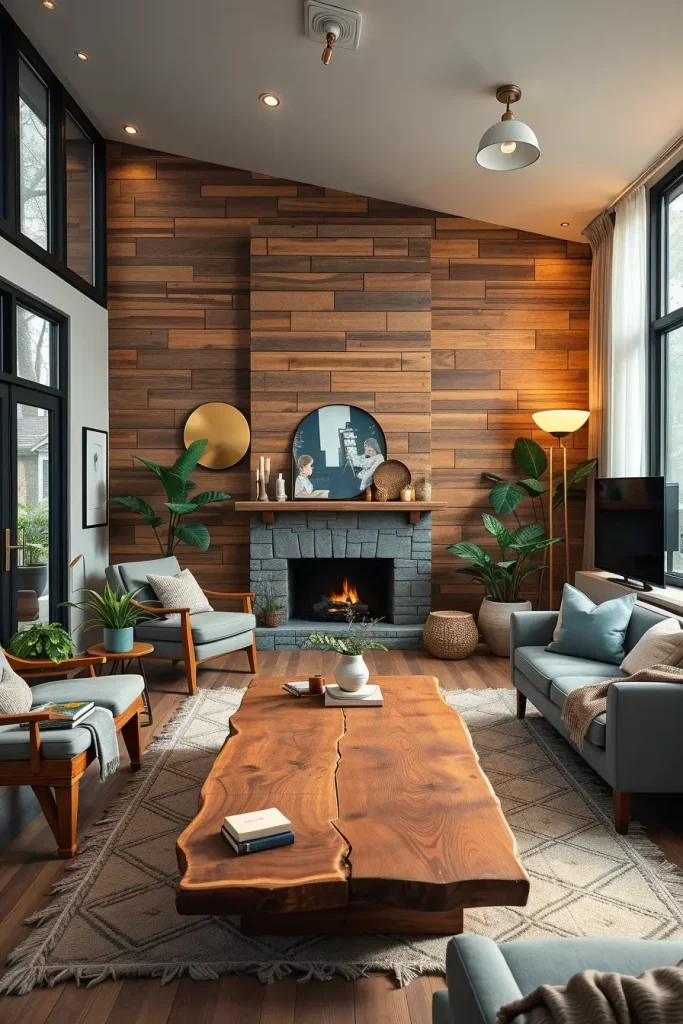
I have been advised by interior designers I have seen on Dwell to use natural oils on reclaimed wood to make it last longer. This gives it a new look without becoming unfriendly to the environment.
Another thing that is mostly ignored is the sourcing process. I also make sure that reclaimed wood is treated against pests and is in good structural condition. This is an extra measure to ensure safety and durability of interiors.
Bamboo And Cork Flooring To Be Stylishly Sustainable
Two materials that I have found myself using as sustainable flooring materials include bamboo and cork. Bamboo is a renewable alternative to hardwood because it grows quickly and regenerates after harvesting. Cork, which is extracted off the bark of cork oak trees, enables the tree to continue growing and also makes the surface underfoot soft and durable.
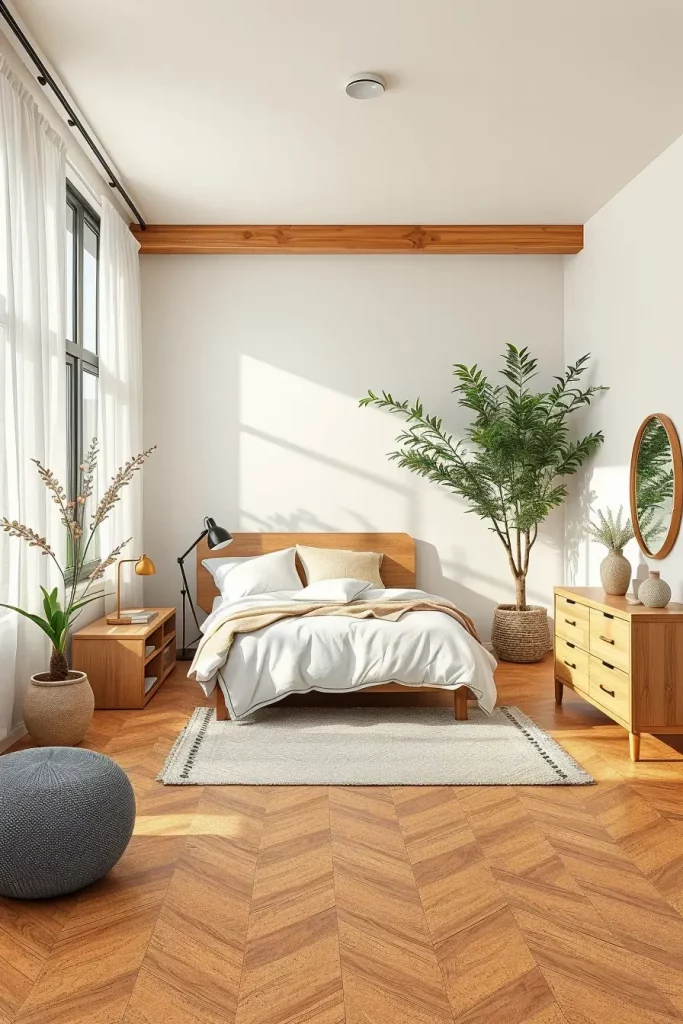
I usually suggest bamboo flooring in the living room due to its smooth look and amazing hardness. Cork is also good in bedrooms and play rooms as it is sound absorbing and warm to the feet. They both go well with light-colored decor and modern furniture, which adds to the green look.
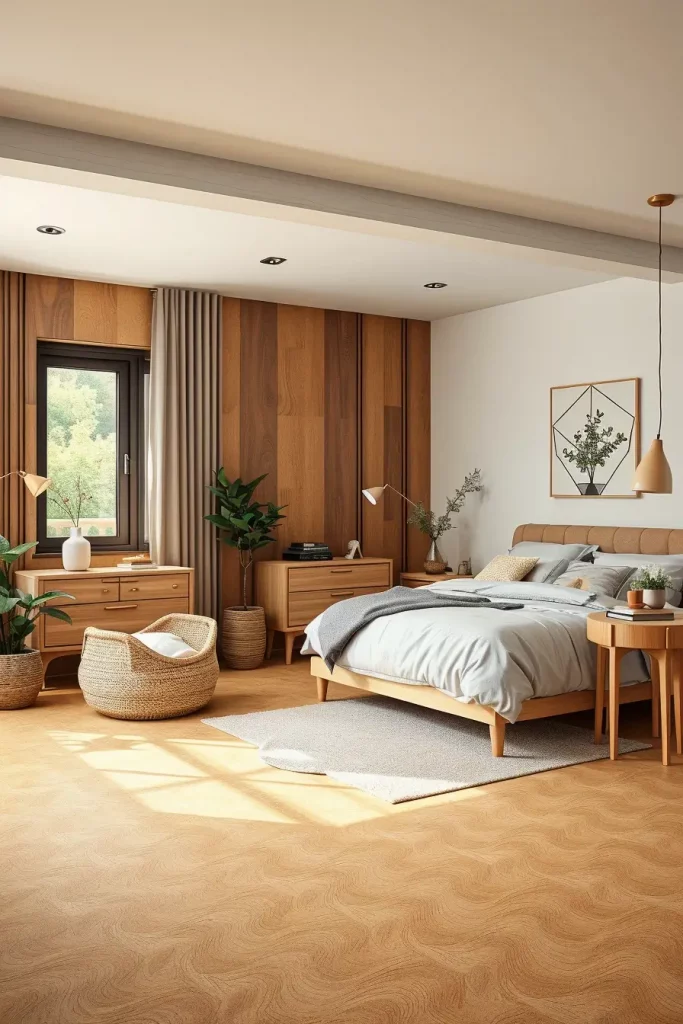
Better Homes and Gardens also claim that cork also provides natural insulation, thus making homes more energy-efficient. My clients are very fond of the comfort of cork, particularly with natural wool or cotton carpets.
The variety of finishes is one of the details that I always include here. Bamboo and cork can also be stained to various colors, allowing the homeowner to be flexible in their choice of interior design style.
Healthy Home Low-VOC Materials
A key component of sustainable interiors is air quality. I would never recommend materials with high VOC which cause off-gassing and poor indoor health. They can be applied on walls, flooring, adhesives and finishes and this is the reason why they are a one stop solution to green living.
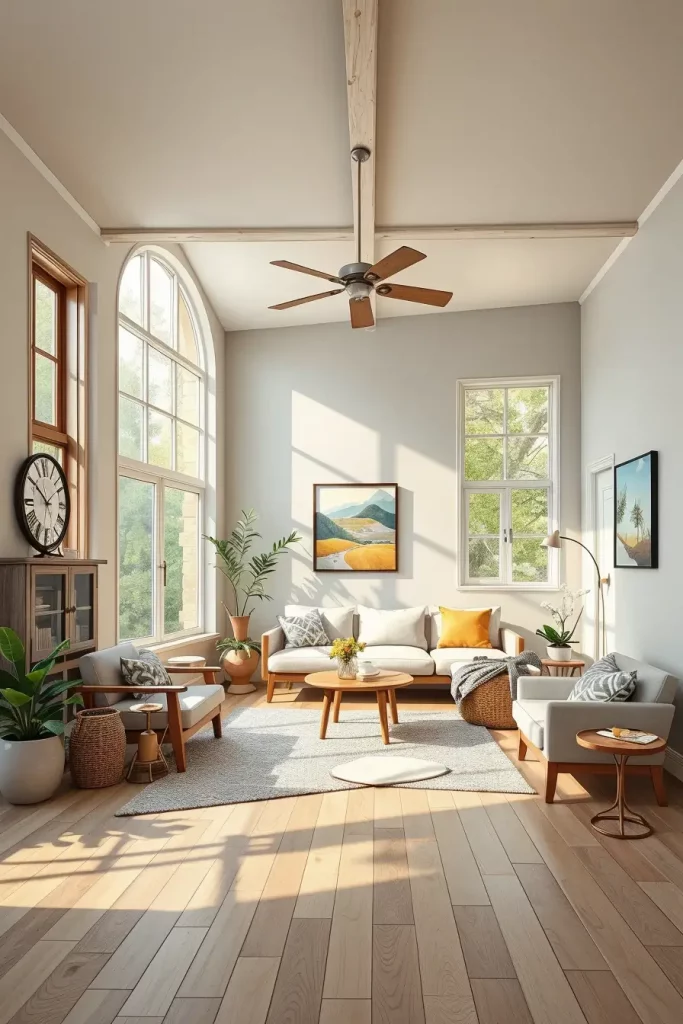
I would use low-VOC drywall, adhesives, and cabinetry finishes in my work. Combined with energy-saving ventilation systems, they produce an environment that is clean and secure. I also mix them with organic cotton fabrics, which help to make the home healthier.
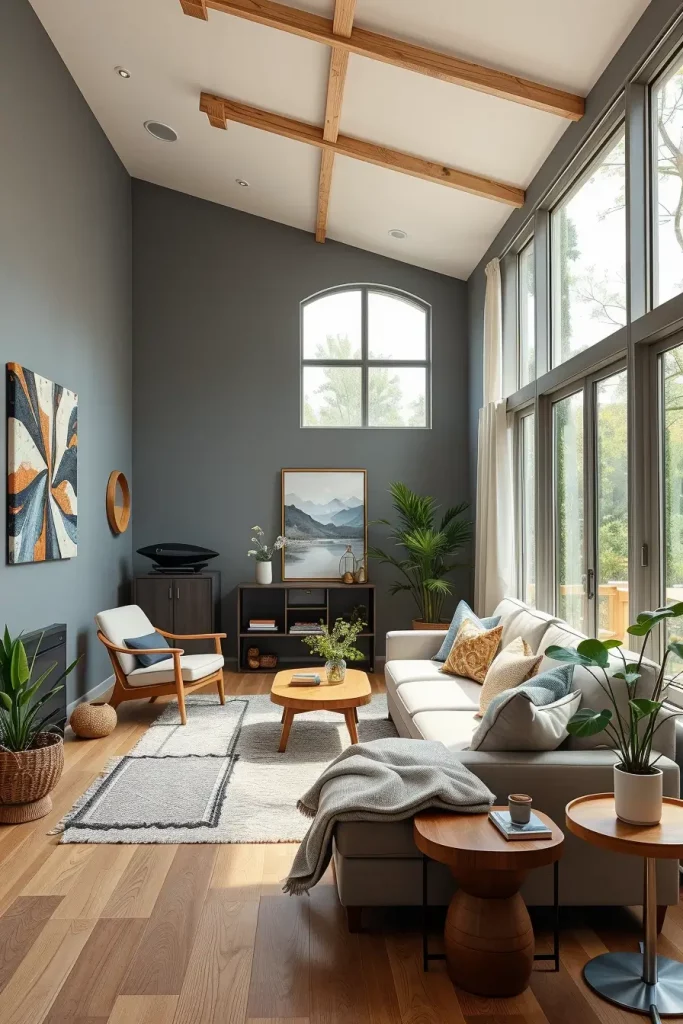
According to design experts at House Beautiful, low-VOC materials are necessary when a family has children or pets. In my opinion, this guarantee usually encourages homeowners to switch.
To complete this part, I would recommend the use of low-VOC upholstery. Most individuals do not remember that sofas, chairs and cushions emit toxic chemicals. Using eco-certified upholstery fabrics would mean the whole room design is in line with the principles of sustainability.
Reused Furniture Pieces with a Character of Their Own
One of my new favorite applications of creativity and sustainability is upcycled furniture. The reimagination of old pieces allows us to increase their life span and decrease waste. An old dresser became a bathroom vanity or an old door became a dining table are only two examples I have used in projects.
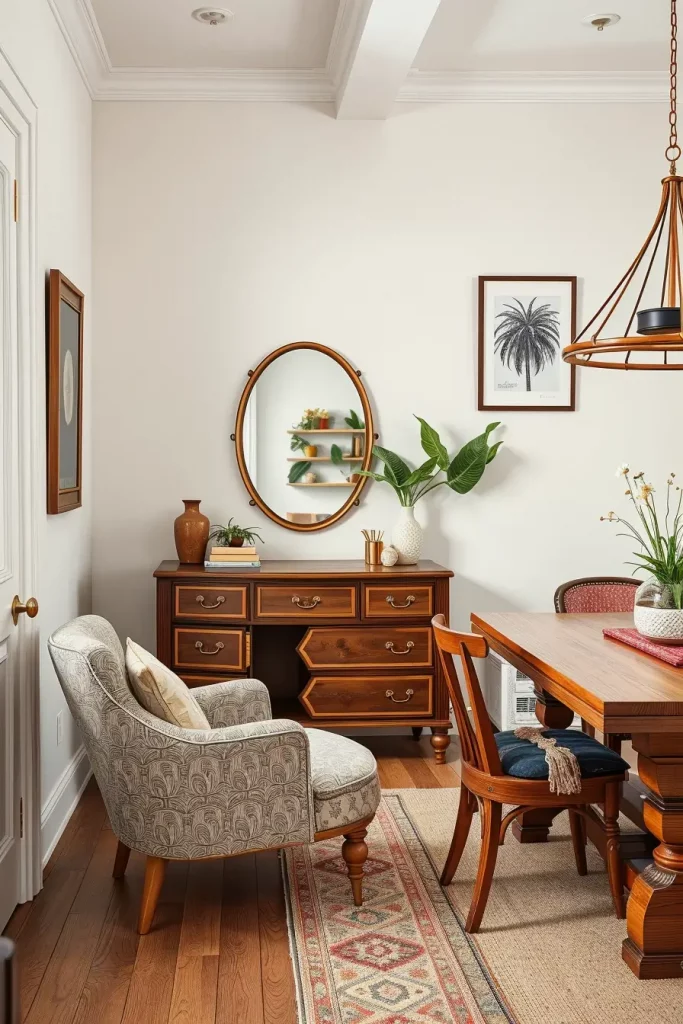
I tend to balance out the modern accents with upcycled furniture. One of them includes a reupholstered old armchair with a side table made of smooth bamboo next to it, which appears personal and unique. The technique renders the interiors distinctive and green.
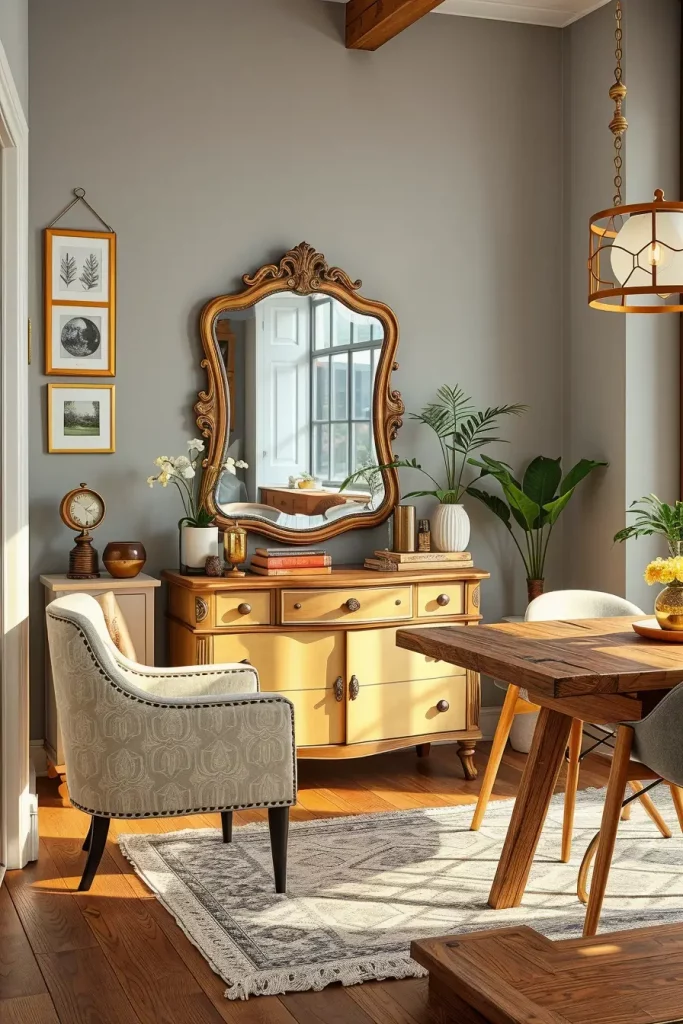
In the Home section of The New York Times, I have read that upcycling is a trend among younger homeowners who want to be original and make environmentally friendly decisions. My clients have shared the same passion with me.
The only thing I never leave out is good refinishing. The application of environmentally friendly paints and stains makes the piece not only appear new, but also compliant with the principles of sustainable decorating.
Thrifted Finds: Decor That Is Stylish but Has a Smaller Footprint
I also always use thrifted products when I need to make my house sustainable without making it look less stylish. The second use of pieces is shopping in thrift stores, flea markets, or online resale stores, which provides a second life to the piece and makes new production less demanded. I have learned that these special things bring personality to a room that mass-produced decor usually does not provide.
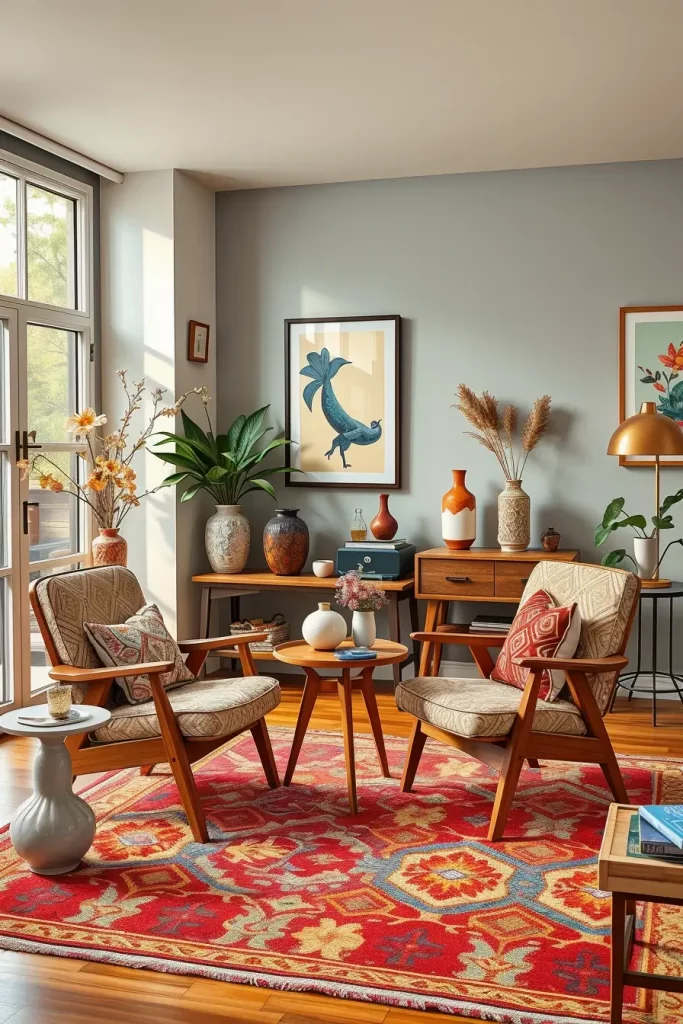
I have frequently used thrifted lamps, ceramic vases and old chairs in living rooms and bedrooms. Not only do these items have a functional use but they also become the topic of conversation. A side table of the middle of the century or a colorful second-hand rug will immediately add a touch of life to the room at a low price and without harm to the environment.
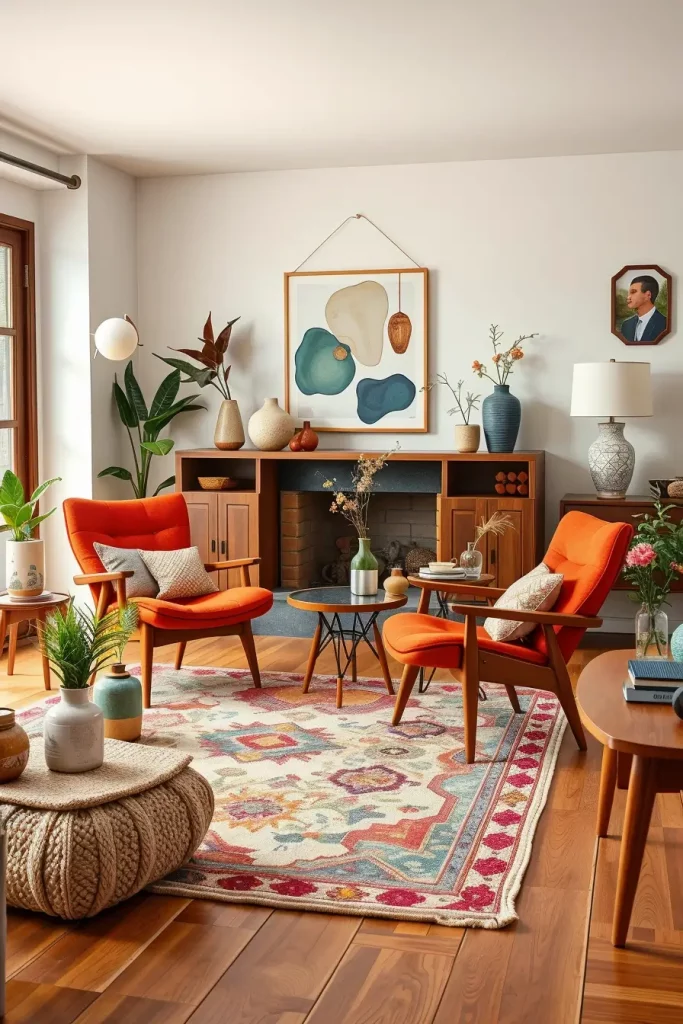
In my experience, most interior designers suggest that thrifted pieces should be combined with new sustainable furniture in order to achieve a balanced appearance. I have been inspired by Apartment Therapy, which suggests mixing the time periods to create a unified but eclectic design that is not accidental.
What is lacking in this approach is maintenance. I would always recommend refinishing or reupholstering thrifted furniture with low-VOC finishes and natural fabrics. This makes the decor look fresh and at the same time sustainable.
Multi-Purpose Furniture To Minimise Waste
Multi-purpose furniture is one of the best methods of sustainable decoration. I tend to plan with items that can be used in multiple ways, eliminating the necessity of having more than one item in the house. A guest room sofa bed, a dining table that doubles as a work desk, or an ottoman with built-in storage are all good examples.
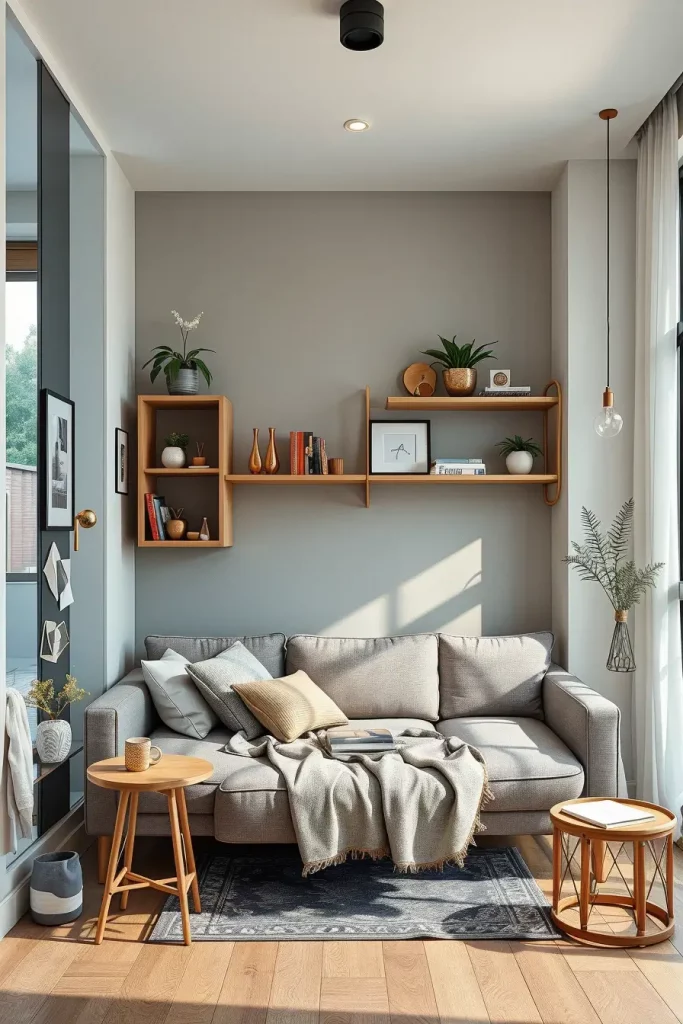
I enjoy incorporating wall mounted foldable desks in small apartments in my projects. They are space saving and have minimal and uncluttered interiors. Another popular one is the modular shelving units, which can be modified to suit changing storage requirements without necessarily having to buy new ones.
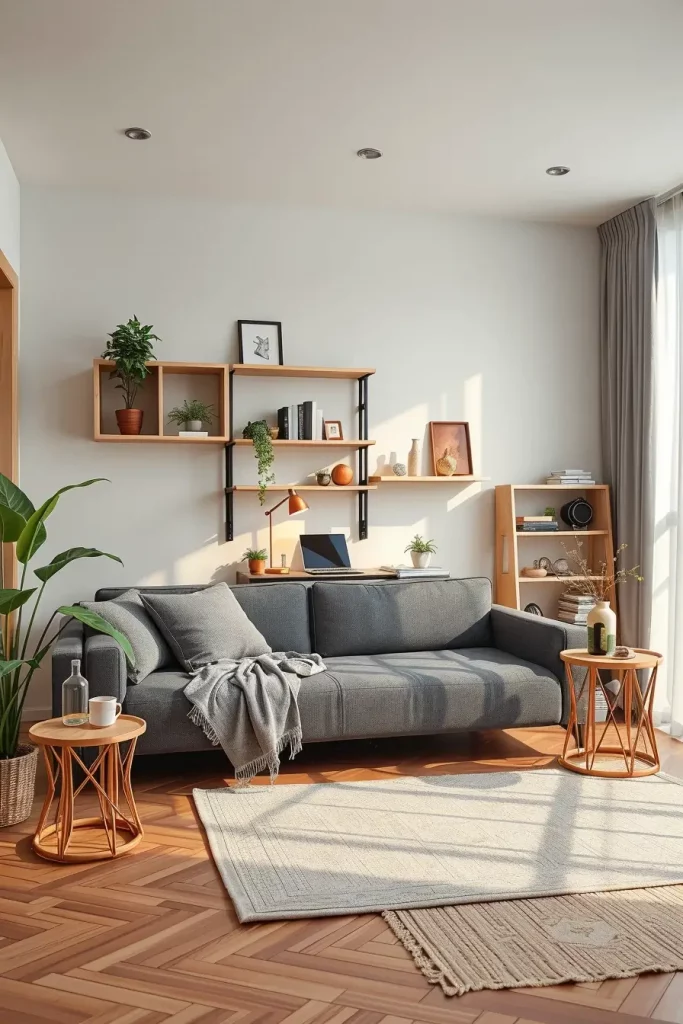
House Beautiful experts tend to suggest multifunctional furniture as an environmentally friendly option, particularly in the city. I have seen how the customers appreciate the functionality of such works, especially when they are matched with the modern interior design styles.
What I tend to include is the significance of the material choice. The sustainability factor can be doubled by selecting multi-purpose furniture that is made of bamboo, reclaimed wood or recycled metals. In this manner, form, functionality, and environmental friendliness all unite.
Lighting that Conserves Energy and Lifts Interiors
Lighting is a big part of interior sustainability. I would always suggest using energy-efficient products like LED bulbs which consume much less energy and have a much longer life span than conventional lighting. In addition to their efficiency, they are available in different color temperatures, which enables me to control the atmosphere of a room.
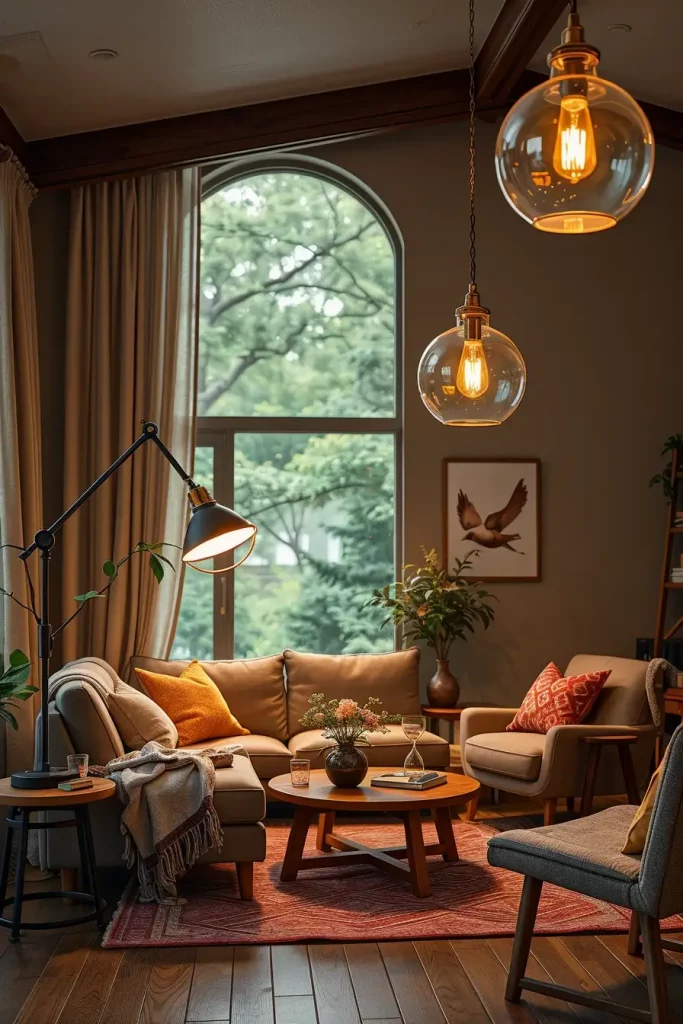
To create focused lighting, I tend to use pendant lights or wall sconces that have LED fixtures. Living rooms with layered lighting using floor lamps and dimmable ceiling lights are practical and low in energy consumption. The balance will make the room stylish without consuming a lot of energy.
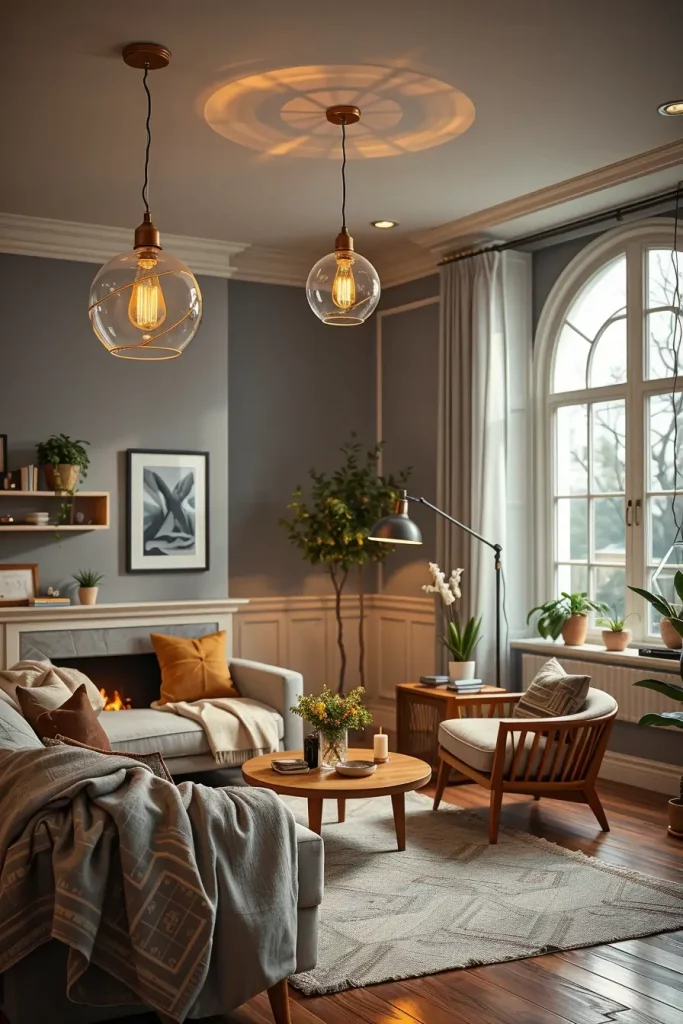
I have already mentioned the sources of the U.S. Department of Energy, which emphasizes that utility bills can be reduced significantly provided that at least some incandescent bulbs are substituted with LEDs. I have seen the contrast between the homes of clients aesthetically and economically.
The only thing that is lacking here is the ornamental aspect of fixtures themselves. To finish the green look, I would typically suggest lighting that is manufactured with recycled glass, bamboo, or eco-friendly metals.
Lighting Solutions LED And Smart Lighting Solutions For Sustainability
My projects have been changed by smart lighting. With LED bulbs and smart systems, the homeowner is able to schedule, control brightness and even change color tones without any complications. Not only does this save energy but also provides every room with its own mood.
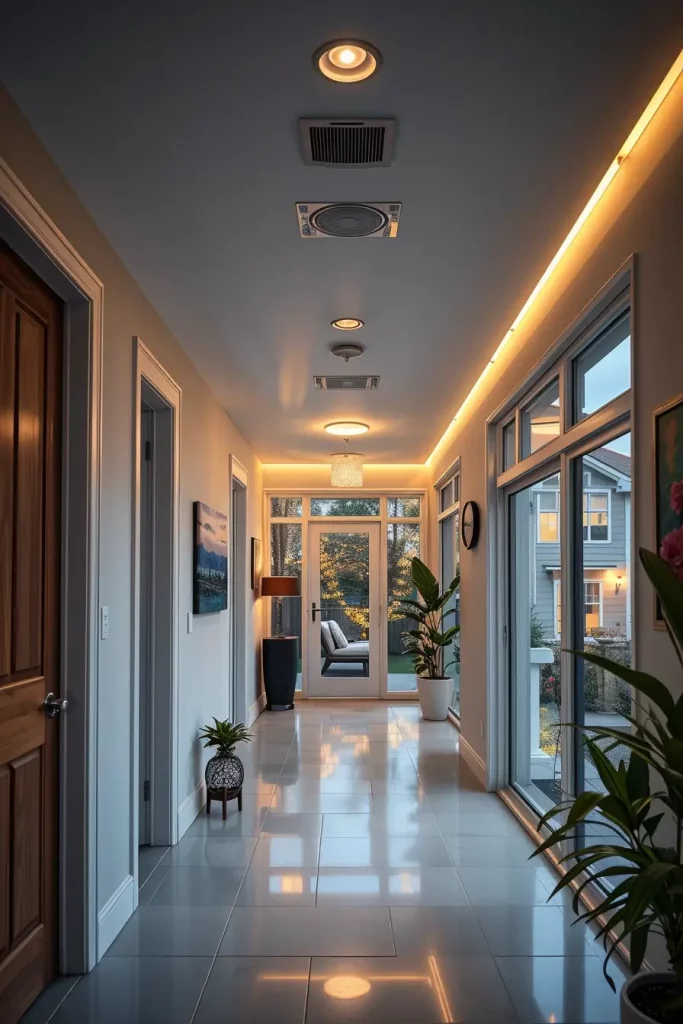
I usually install motion-sensing lighting and smart dimmers in halls and bathrooms in my designs. This will make sure that there is no unnecessary lighting. The programmable lighting system can be applied to the bedrooms to simulate sunrise to promote healthy sleeping habits.
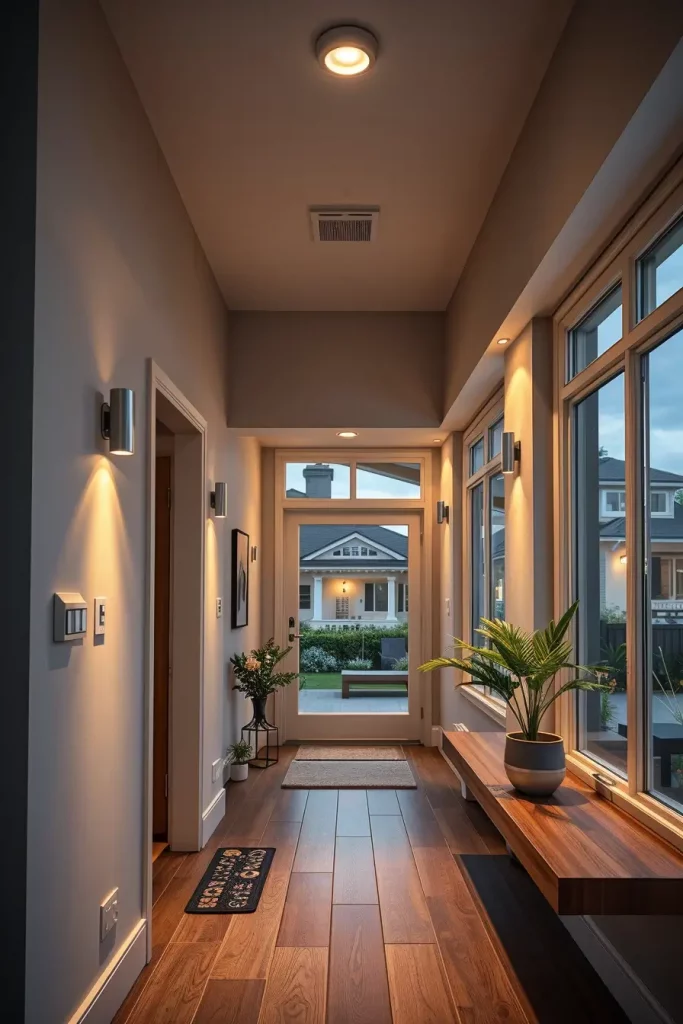
The smart lighting coupled with the broader home automation systems make the house more efficient and convenient, according to design experts at Forbes Home. I have applied this to modern apartments and the customers appreciate the smoothness of the operation.
Another feature that I would suggest is the addition of exterior lighting that is solar powered. It adds curb appeal and safety to the overall home design and extends sustainability outdoors.
Using Natural Light by Smart Design
I use natural lighting as the main source of light whenever I can. Intelligent design solutions such as the strategic positioning of windows, skylights and glass doors maximize daylight and reduce artificial lighting. I think this is also a better way to enhance well-being as it links people to the outdoors.
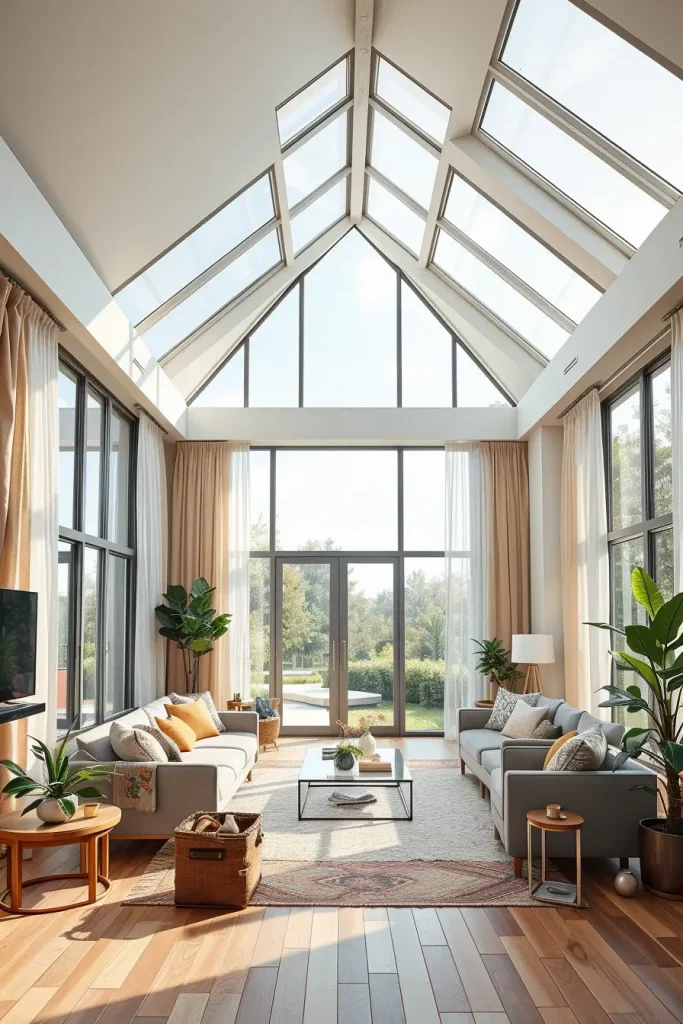
I tend to use huge south-facing windows, reflective surfaces, and light-coloured walls in my projects to increase brightness. Sheer organic curtains made of cotton prevent sunlight penetration, yet allow natural warmth through the curtains, ensuring privacy.
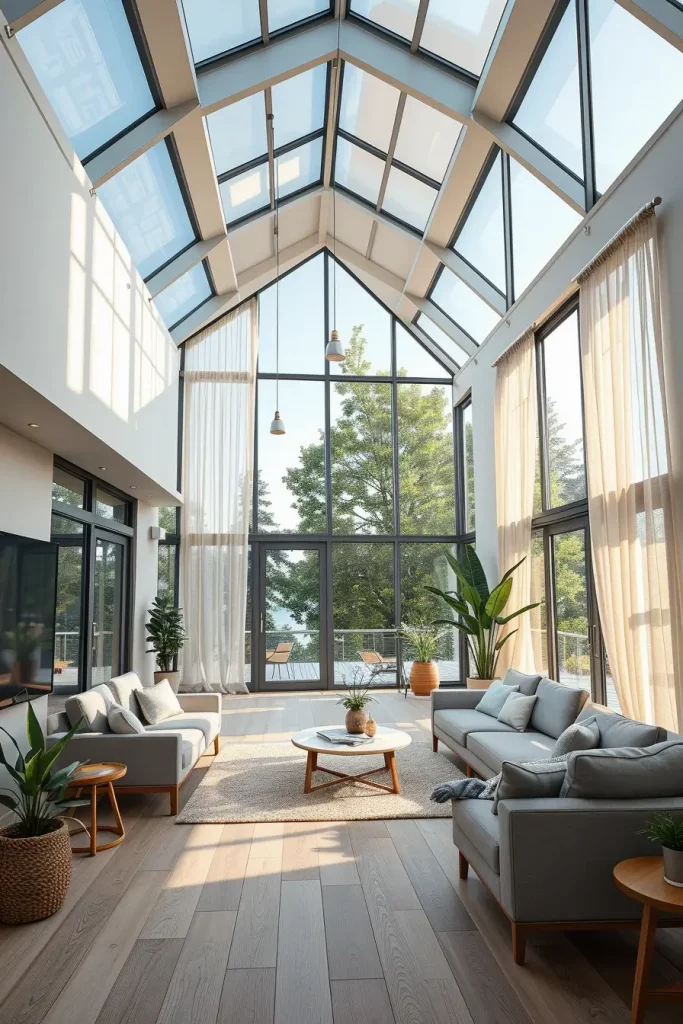
I have been taught by design experts at Architectural Digest that natural light can enhance moods and it can also be used to control circadian rhythms. At the individual level, I have had the opportunity to see how customers are more productive and refreshed in naturally lit places.
What I frequently include here is the use of interior layouts that are conducive to light flow. Glass partitions and open plan designs enable the sun to penetrate deeper into the house and eliminate the use of artificial sources.
Indoor Plants To Purify And Beautify Spaces
One of the simplest and most beautiful methods of improving sustainability in interiors is through indoor plants. They are natural air purifiers that eliminate toxins and add freshness and liveliness to the room. I also learn that plants bring harmony and a calming effect to interiors, and make houses more welcoming.
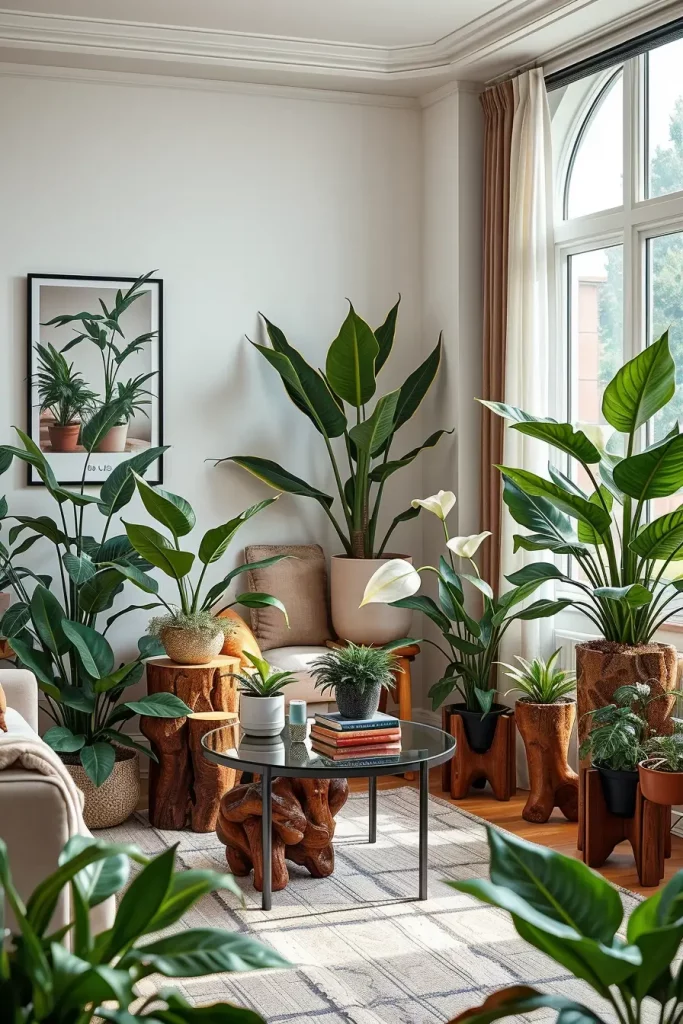
I tend to incorporate plants that require minimal care such as snake plants, pothos, and peace lilies in my designs. They are indoor plants that do not need many resources. Bigger plants such as fiddle-leaf figs or palms are great statement pieces in living rooms, providing both height and texture.
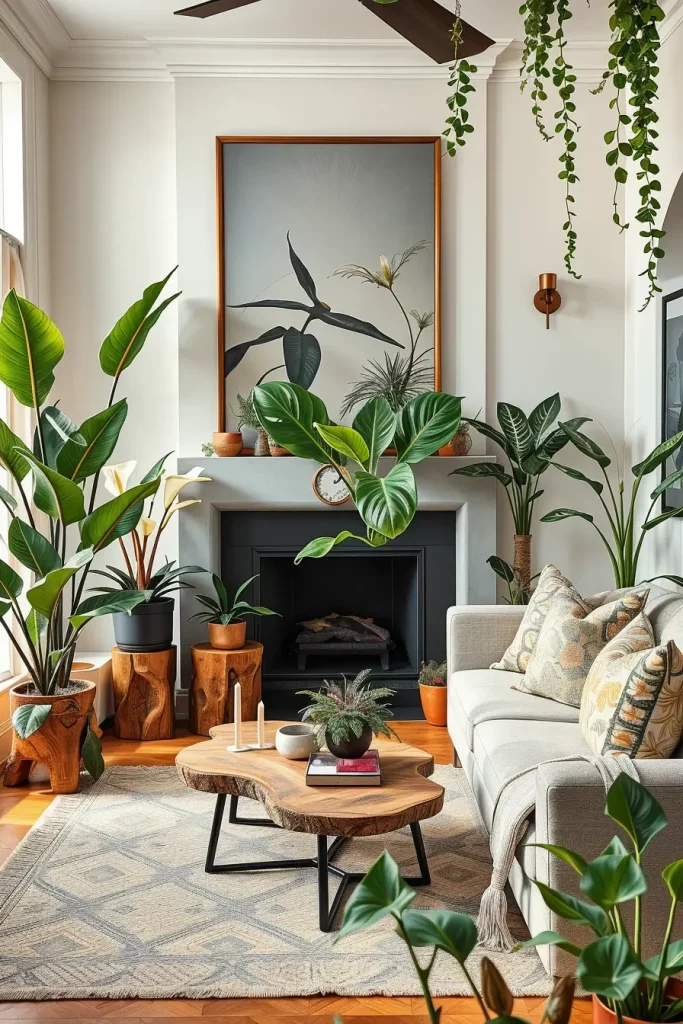
Design experts at The Spruce claim that plant grouping will increase humidity and indoor air quality. I myself have witnessed the impact of this not only in the healthier environment, but also in the beautiful ornamentation.
To achieve this section I would propose that we would be using environmentally friendly plant holders that could either be ceramic pots or reused wood stands or woven baskets to continue the same theme of being environmentally friendly.
Vertical Gardens To Small Environmentally Friendly Homes
Vertical gardens are a perfect solution when there is a lack of space. I have installed them in flats, small houses and even offices. They make the most of greenery without occupying floor space, forming a living wall that serves as decor and natural air purifier at the same time.
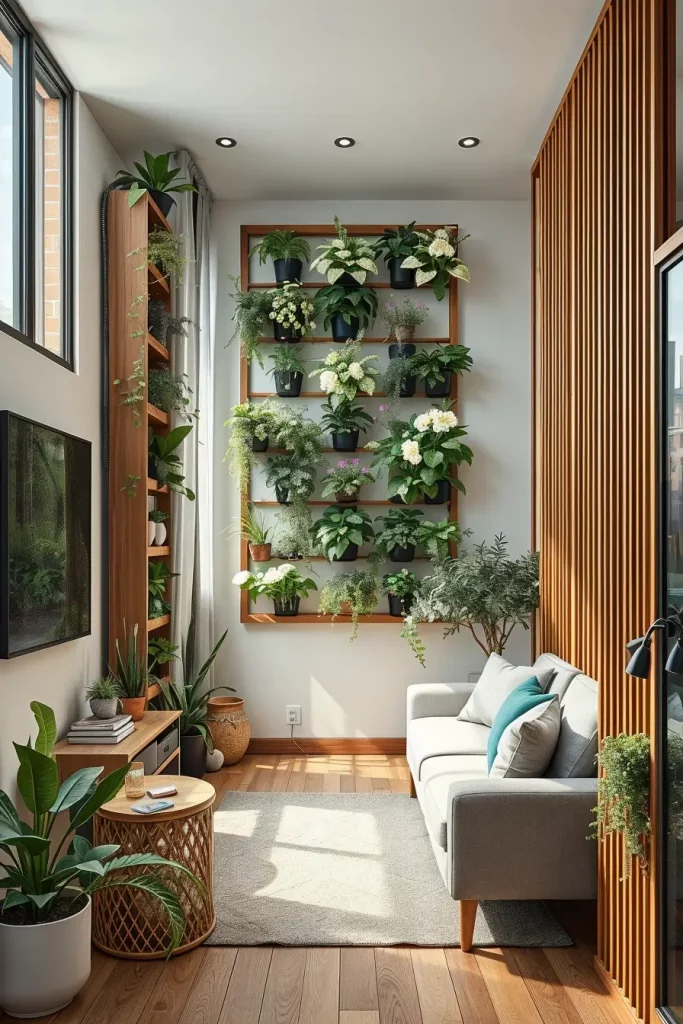
Modular vertical garden systems are commonly used in my projects where homeowners can grow herbs, flowers, or even vegetables inside. This makes a practical and viable extension to the house. They are also paired with natural wood frames which make plain walls look warm.
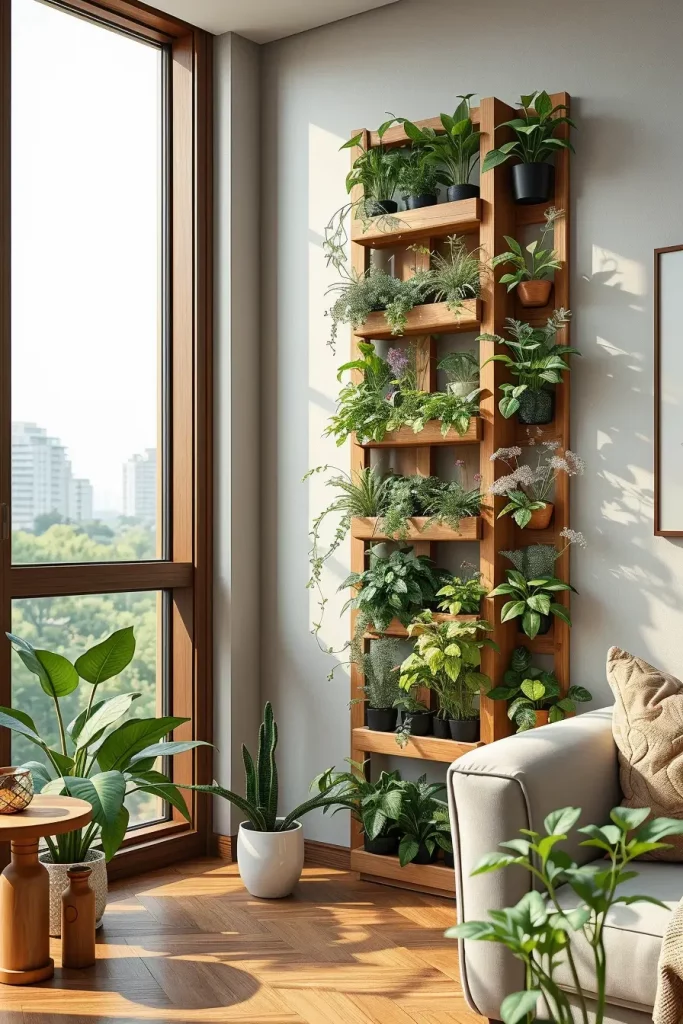
I have read in Elle Decor that vertical gardens are particularly well received in urban life as they offer a design element as well as a connection to nature. I have had clients fall in love with the thought of growing herbs in their own wall garden.
What I can contribute to such a strategy is the significance of irrigation. With a properly designed drip system, plants will grow without a lot of wasted water, keeping the home interior design realistic and environmentally friendly.
Organic Fabrics For Cozy Sustainable Living
Organic fabrics are always my starting point when creating a sustainable interior since they make the living environment warm, welcoming, and free of toxins. Selecting fabrics that are made of organic cotton, linen, or hemp can ensure the quality of indoor air and is also non-harmful to the environment. They are breathable and natural fabrics and can be used as upholstery, cushions, and throws.
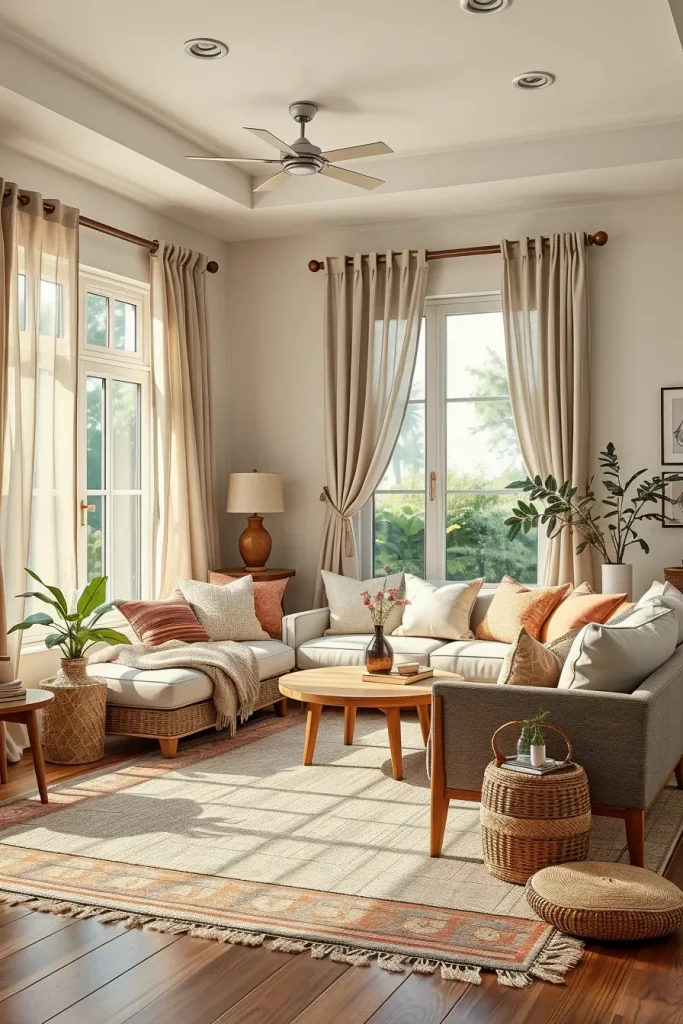
I typically recommend organic cotton slipcovers to the sofas, linen curtains that can bring natural light into the house, and hemp rugs that are long-lasting and biodegradable. Not just does each piece contribute to character, but it also ensures that the eco-friendly nature of your home is not compromised by the use of harmful pesticides or synthetic fibers.
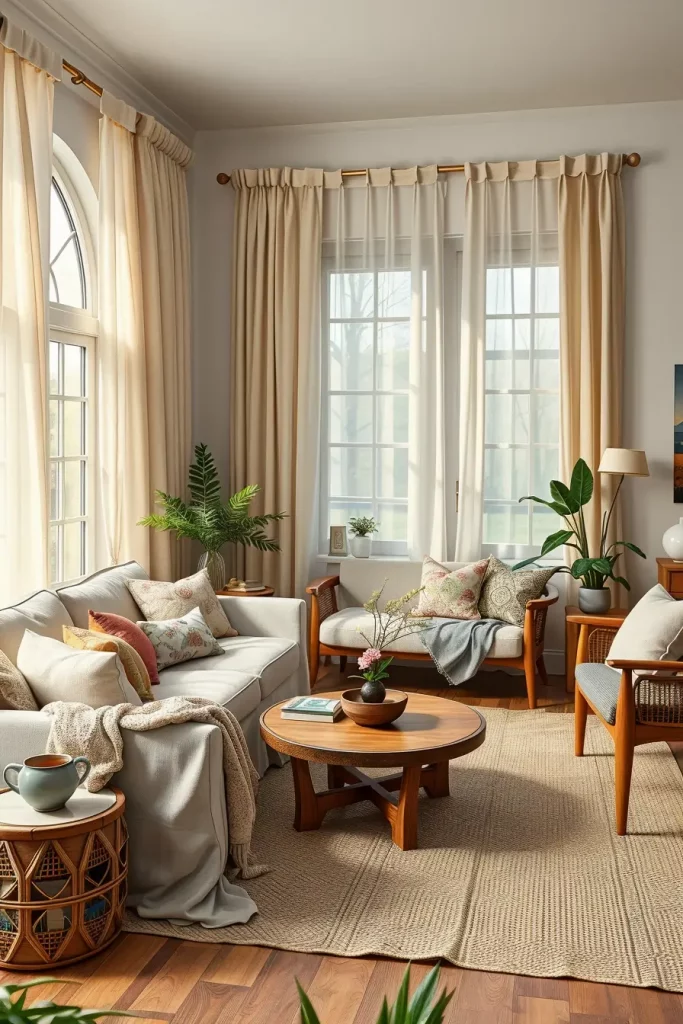
On a personal level, I have witnessed clients change their living rooms and replace their hemp-infused curtains and organic cotton cushions. According to interior designer Bobby Berk, soft fabrics crafted out of natural fibers are the only way to achieve a natural comfort that artificial substances cannot possibly imitate.
I would also incorporate some other alternatives such as organic wool to create warm blankets and bamboo mix to create bedding so that this section could be more customizable with the goal of becoming comfortable and sustainable.
Cotton, Linen, And Hemp Textiles For Interiors
Textiles are a significant part of sustainable decorating. I like cotton, linen, and hemp because they are renewable, biodegradable and versatile. They provide a home with a natural feel that is easy to maintain, and is also simple to look at and appreciate.
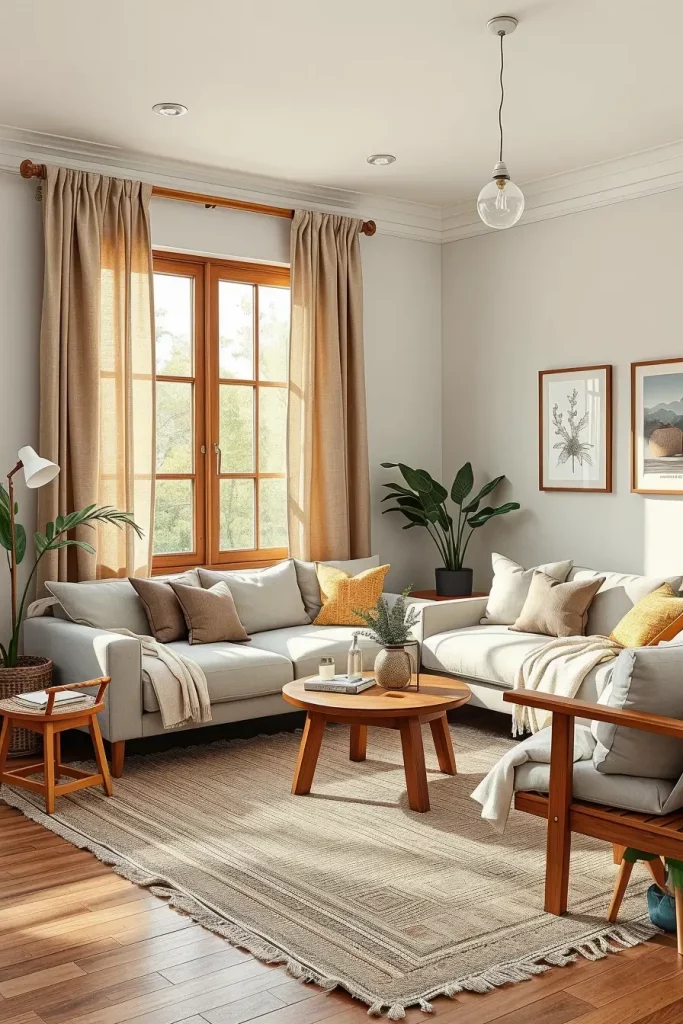
In practice, I would suggest linen upholstery on the accent chairs, cotton slipcovers on the high-traffic sofas, and hemp-blend rugs on the living rooms. Not only are these materials stylish, but they are also practical as they grow older, becoming softer instead of becoming worn.
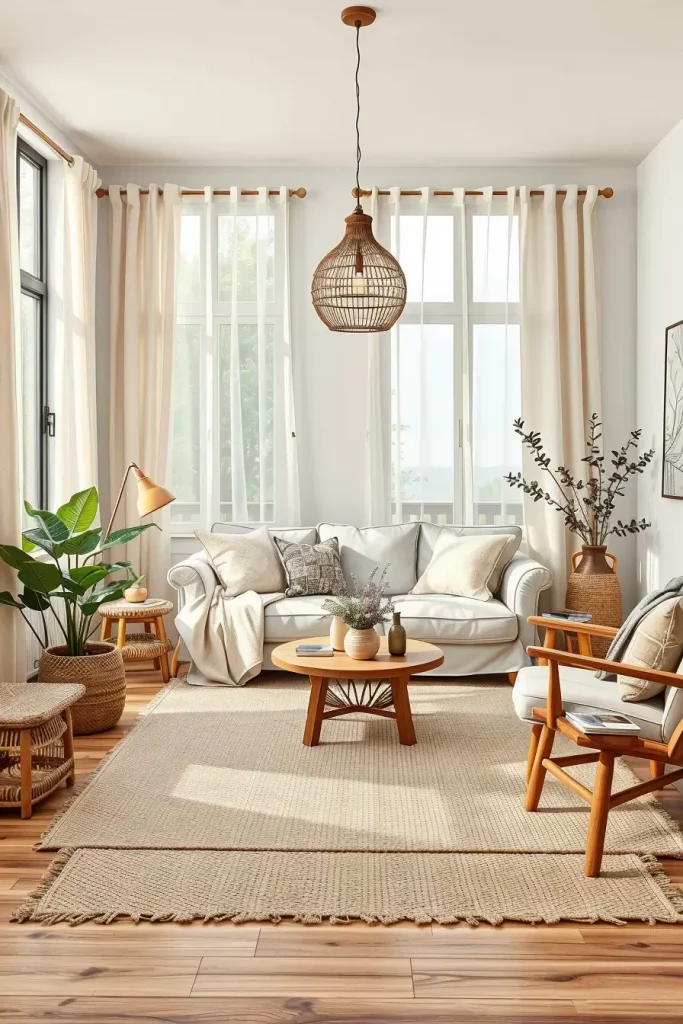
In my opinion, the difference between polyester and linen curtain is quite obvious–in terms of appearance and smell. Architectural Digest suggests that more and more homeowners are moving towards linen and hemp fabrics to support their environmentally-conscious beliefs without sacrificing style.
The significance of wearing naturally dyed fabrics would also be included in this section by me. Plant dyes are subtle and earthy and can be used in any design scheme without the chemicals present in synthetic dyes.
Non-Toxic Rugs And Carpets For Cleaner Air
Non-toxic carpets and rugs are one of the simplest methods of improving indoor air quality, which is an important aspect of sustainable interiors. Most conventional alternatives emit VOCs (volatile organic compounds) that can hang in the air over a period of years. Non-toxic options make the house healthier and are also stylish.
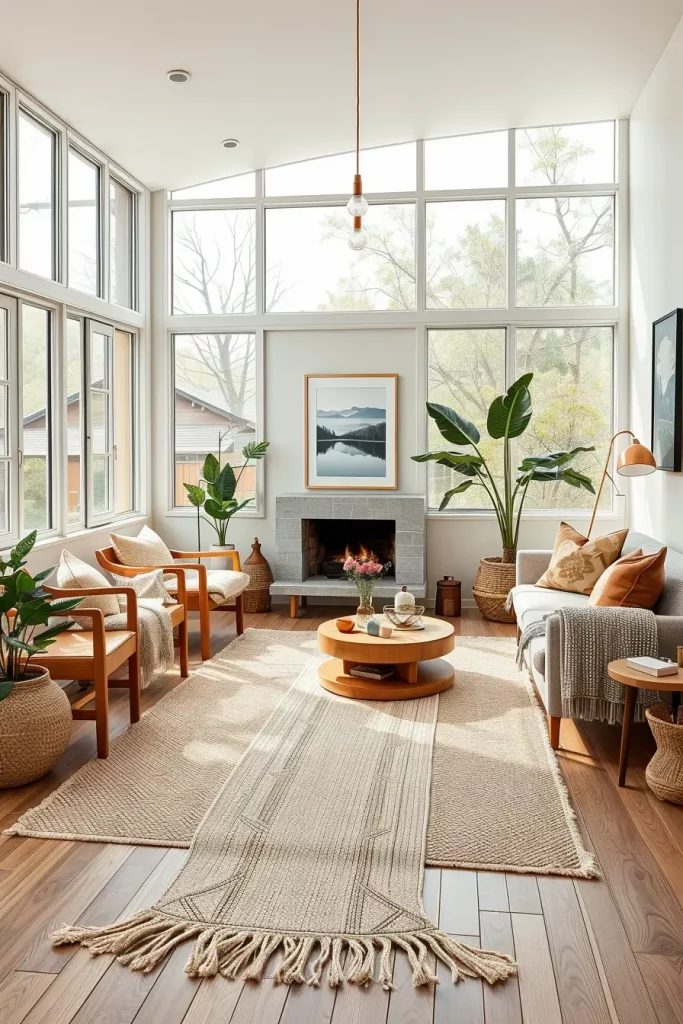
I tend to prescribe wool, jute, or sisal rugs. These are natural fibres that are biodegradable and untreated with chemicals. Not only does a wool area rug in the living room or a sisal runner in the hallway provide texture, but it is also durable without compromising sustainability.
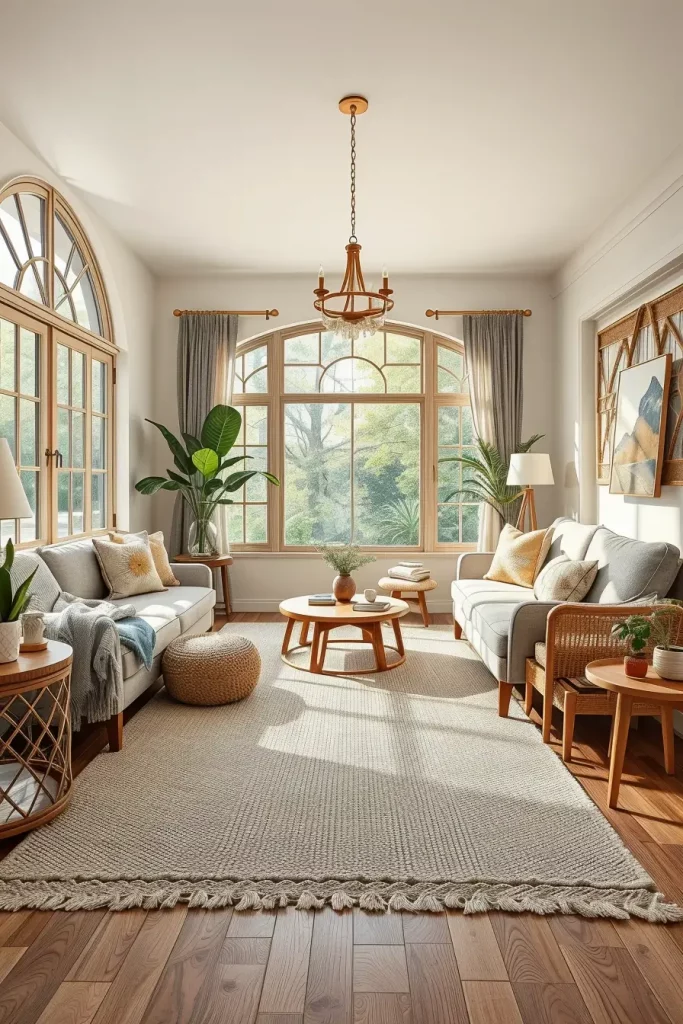
In my personal projects, I have observed that the clients perceive the difference as soon as synthetic carpets are substituted with non-toxic ones. The house is cleaner, and it is also easier to maintain because natural fibers cannot accumulate dust. The U.S Environmental Protection Agency also emphasizes on the use of low-emission materials in order to minimize harmful indoor pollutants.
To support this section, I would add the idea of adding layers of different sustainable fabrics to make big open spaces look more visual and comfortable.
Eco-Friendly Curtains And Drapes For Every Room
Curtains and drapes are not only decorative, but also play a role in energy conservation. Installing greener curtains and drapes of organic or recycled fibers will assist in controlling the temperatures inside the building, reducing the energy costs and cutting down on wastage.
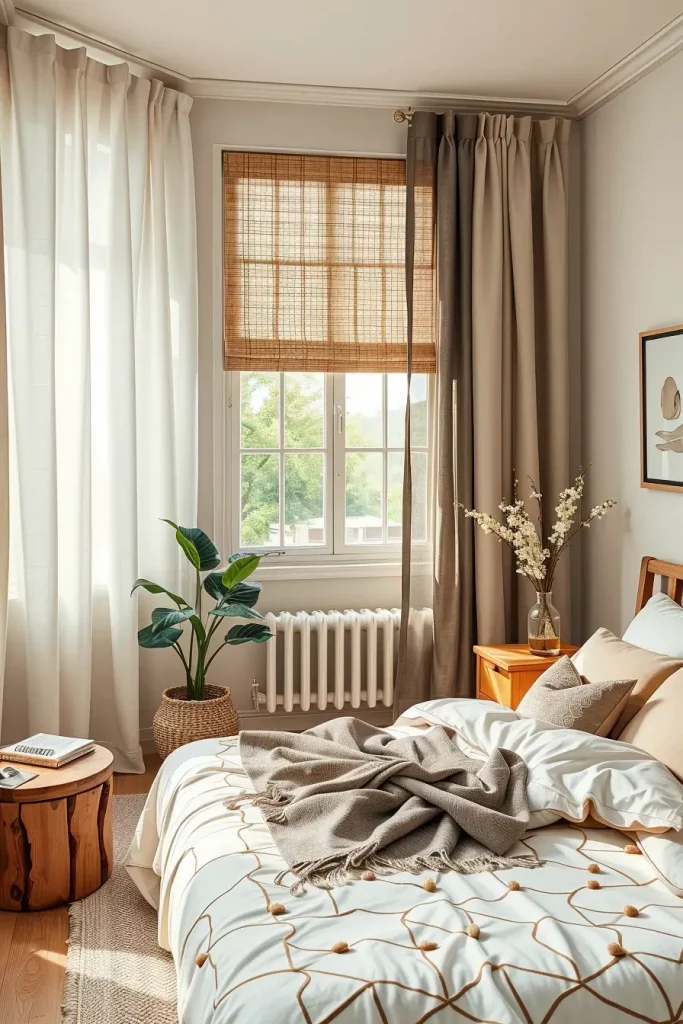
I suggest thick linen drapes in living rooms of most houses to keep out the unwanted heat during summers and to keep in the warmth during winters. In the bedroom, blackout curtains made of organic cotton are an excellent choice to ensure a better sleep. Blends of recycled polyester are also becoming popular as they provide a second life to plastic waste and remain practical.
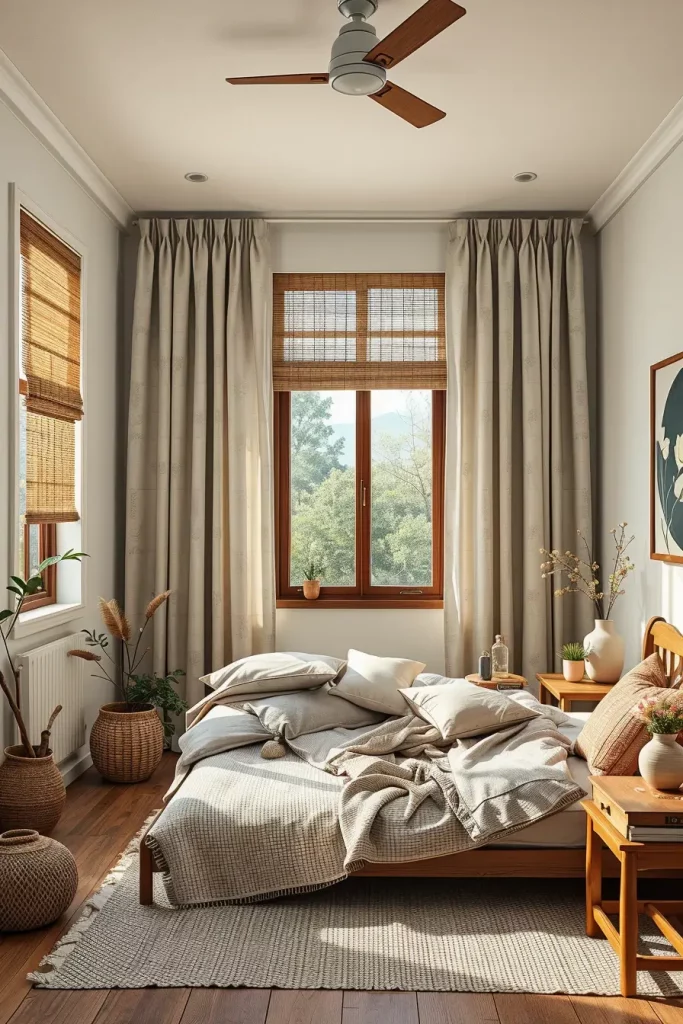
I think that drapes are not usually considered as a sustainable design component. I have witnessed homeowners save a lot of money on heating and cooling expenses by merely replacing their regular curtains with thermal-lined environmentally friendly curtains. Sustainable textiles have also been listed by Elle Decor as one of the most influential small changes in modern interiors.
Another addition that I would include is the use of bamboo shades to match fabric drapes. They provide a natural light control that has sustainable merit and a stratified look.
Natural Stone And Clay For Earthy Elegance
There are not many materials that are as timelessly elegant as natural stone and clay. These elements bring in a sense of longevity, naturalness and closeness to nature. The use of stone walls, clay tiles and terracotta accents provides a grounded element that immediately contributes to sustainable interiors.
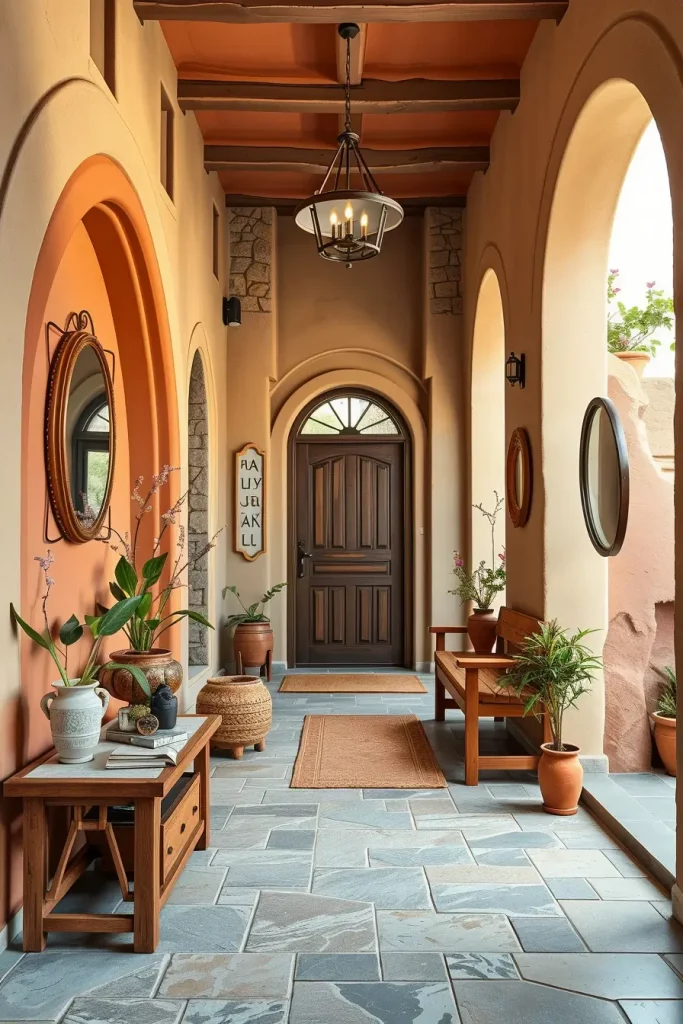
I tend to use clay plaster on accent walls, marble countertops on kitchens, or stone tiles on entryways. They are also eco-friendly and powerful materials that do not need a lot of maintenance and can therefore be used in environmentally friendly houses.
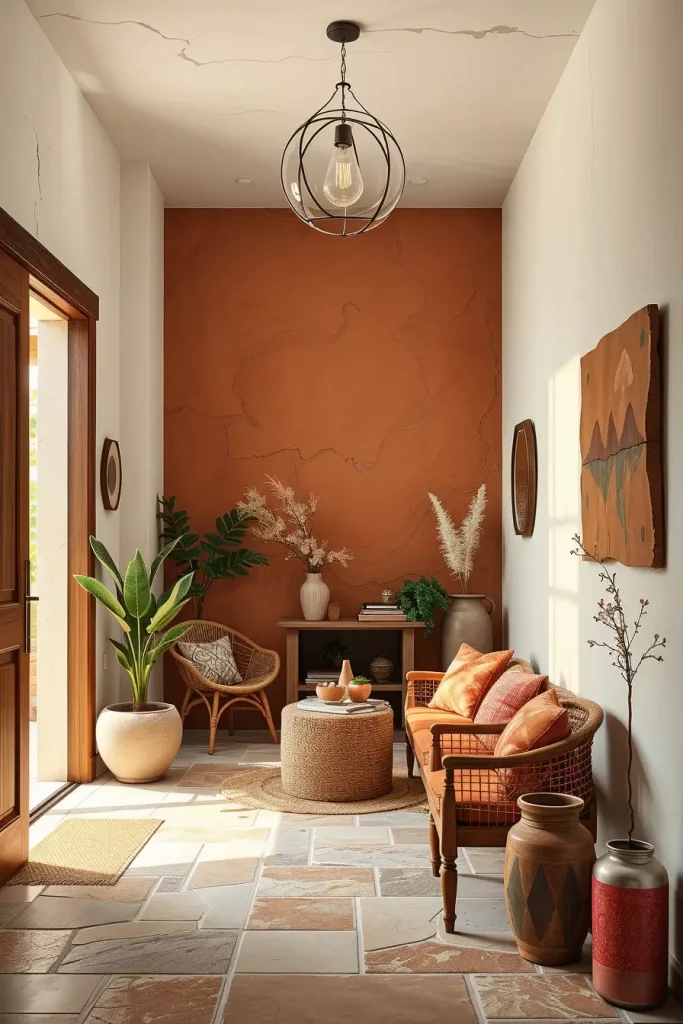
In my own opinion, natural stone brings permanence and quality to a home. Natural materials such as stone and clay are often touted by designer Nate Berkus as materials that grow more beautiful with age instead of fading away.
I would also add to this section that reclaimed stone and clay products would help lower the extraction of new resources but still provide the same natural appearance.
Recycles Glass Decor To Sparkle and Sustainability
One of my favorite methods of adding glitz without damaging sustainability is recycled glass decor. Glass can be recycled over and over again in the form of vases, light fixtures, and even countertops, and it will still be clear and beautiful.
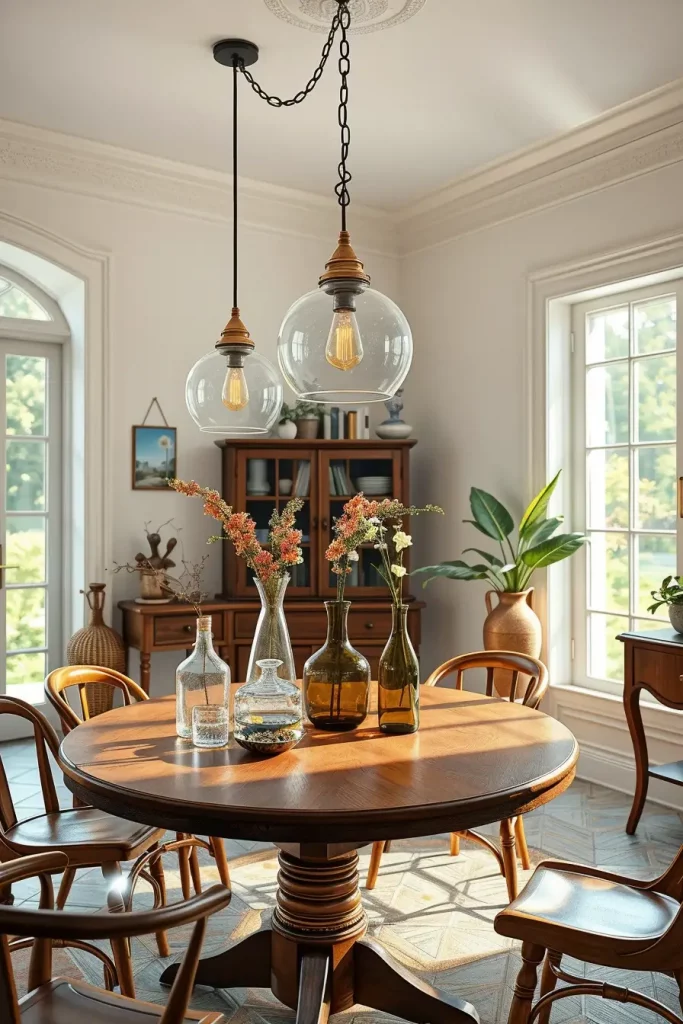
I tend to suggest glass pendant lighting in the dining rooms, recycled glass tiles on the kitchen floor, and ornamental vases on the coffee tables. These products are aesthetically pleasing, are a great way to reflect natural light, and minimize landfill waste.
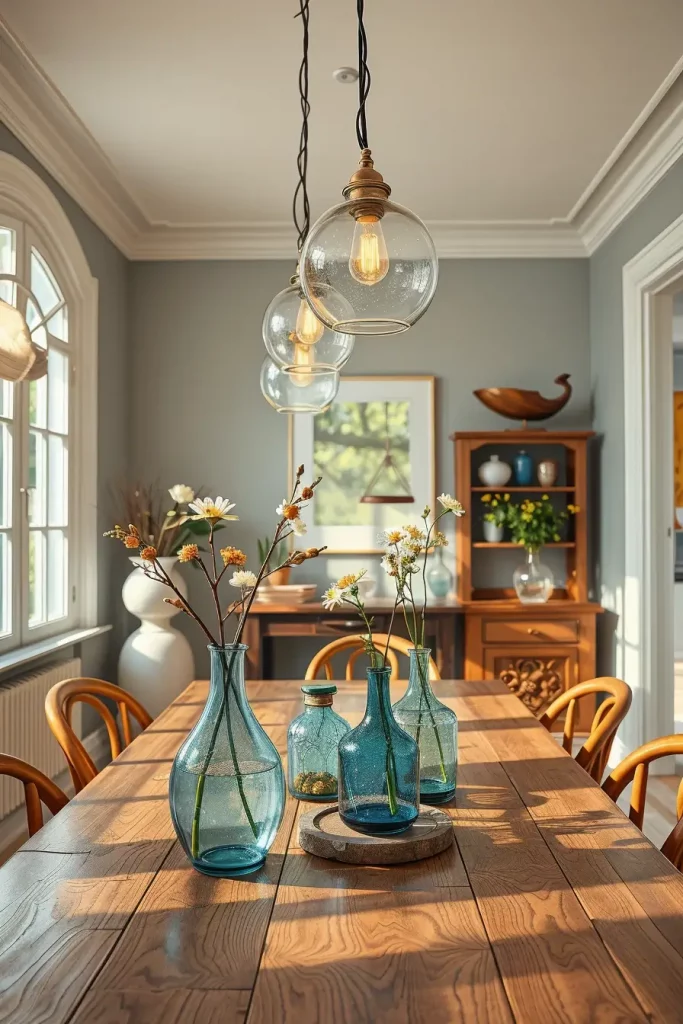
I have worked on a few kitchen projects with recycled glass countertops and clients adore the speckled look that is not available in the synthetic materials. House Beautiful says that recycled glass decor is becoming trendy as a means of adding flair without sacrificing the green ethos.
I would also incorporate bigger design features such as recycled glass wall panels that create bold statements in the entrance or bathroom but are sustainable.
Water-Saving Fixtures For Eco Bathrooms
One of the most resource-consuming spaces in the house is the bathrooms, and water-conserving fixtures are necessary to live sustainably. Low flow faucets, dual flush toilets and water efficient showerheads minimize consumption without compromising comfort.
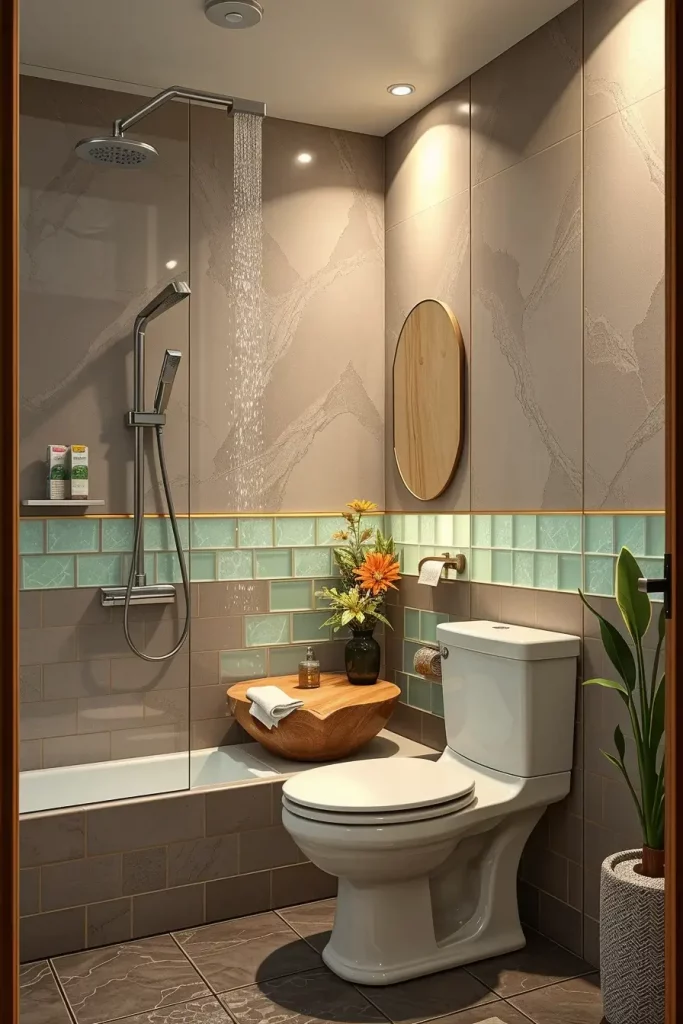
I would normally recommend fixtures that are performance-based and WaterSense certified. Fitting a rain-style low-flow showerhead or a smooth two-flush toilet can be a sleek addition to the house and can reduce water consumption by a significant margin.
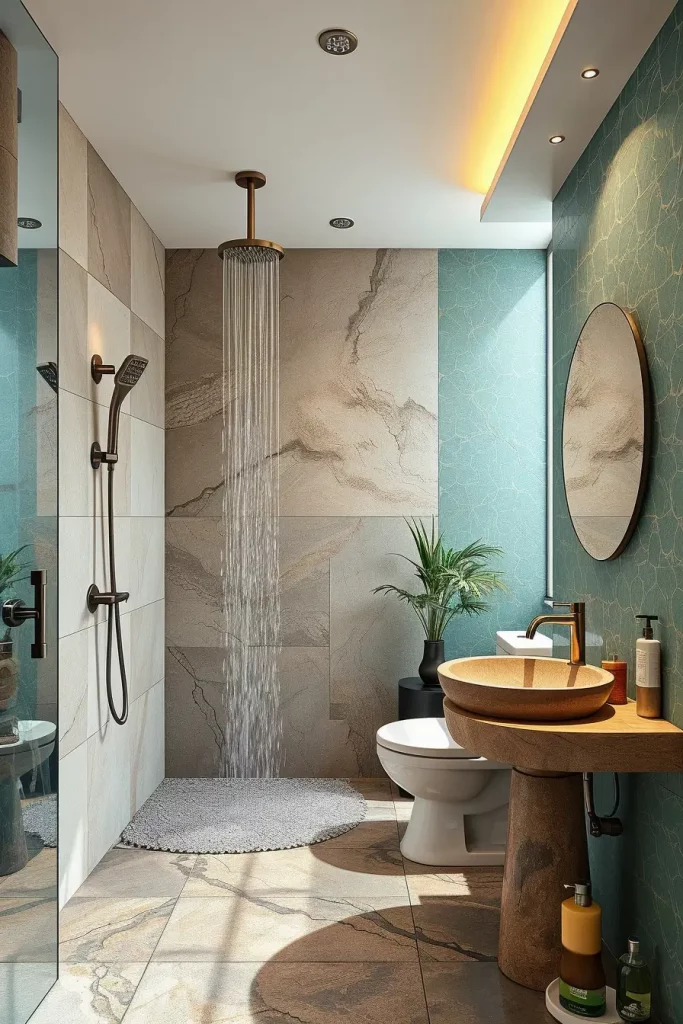
Experience has shown that clients are usually surprised to find that the difference in water pressure between using efficient fixtures and using some that consume more water is minimal. Indeed, Consumer Reports points out that current water-saving technologies are not only highly functional but also minimise waste.
I would also include the concept of motion-sensor faucets in family bathrooms to improve this section as they are particularly effective in minimizing unintentional water wastage.
Green Kitchen Design Using Renewable Materials
A kitchen is a very common aspect of the house and its sustainability can greatly influence the environment. I would also look at renewable materials such as bamboo, used wood and recycled metal to provide durability and limit waste. These decisions make the kitchen warm and inviting and timeless but environmentally friendly.
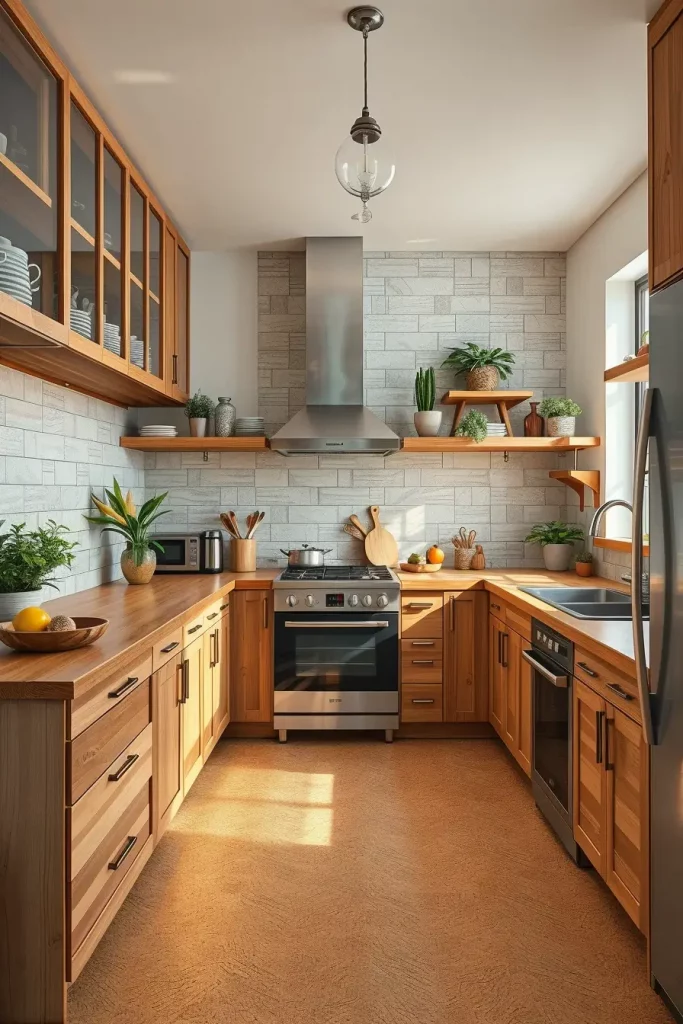
In the case of cabinetry, bamboo is an excellent choice since it is strong, light, and grows fast, which makes it one of the most renewable resources on the market. Reclaimed wood works well in countertops and open shelving to provide the space with character and history. The design is finished with stainless steel appliances that are recycled and have a smooth and futuristic feel.
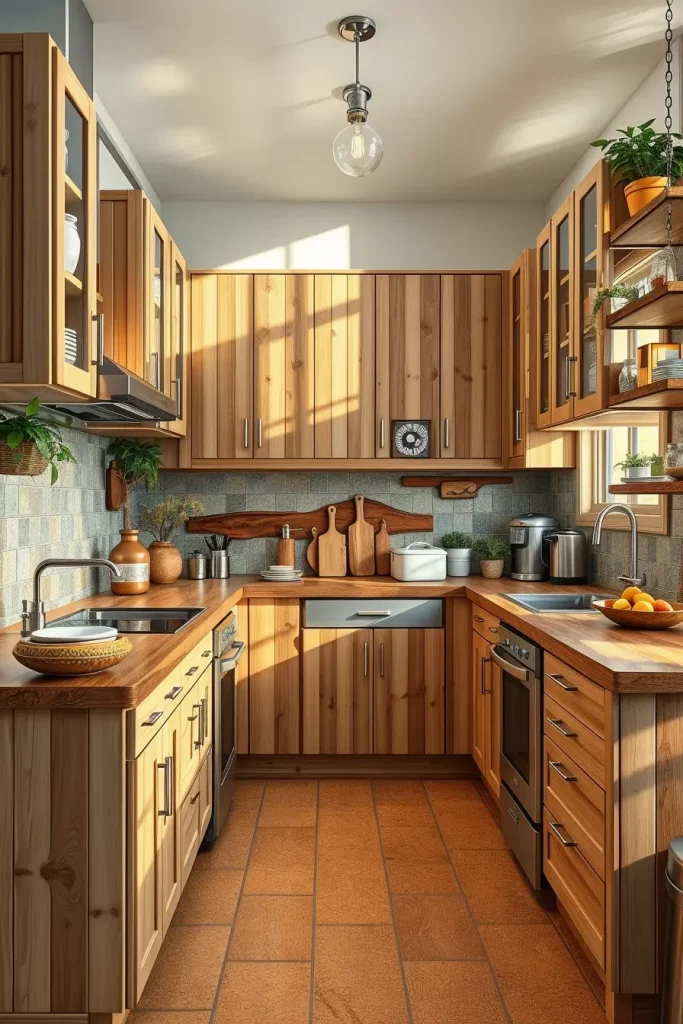
In my opinion, sustainable kitchens are beautiful, as well as useful. I have also had clients adopt recycled glass countertops that do not only appear impressive, but are also heat and stain resistant. Better Homes and Gardens state that bamboo has become one of the most popular materials to use during eco-friendly renovations due to its strength and sustainability.
I would also include cork flooring to this area as it is a renewable and strong flooring material that offers natural insulation and underfoot comfort.
Composting Solutions For A Cleaner Home
A really sustainable home should have waste minimization solutions and composting is one of the best solutions. Food scraps can be used as useful nutrients in the kitchen or garden by incorporating compost systems rather than going to landfills.
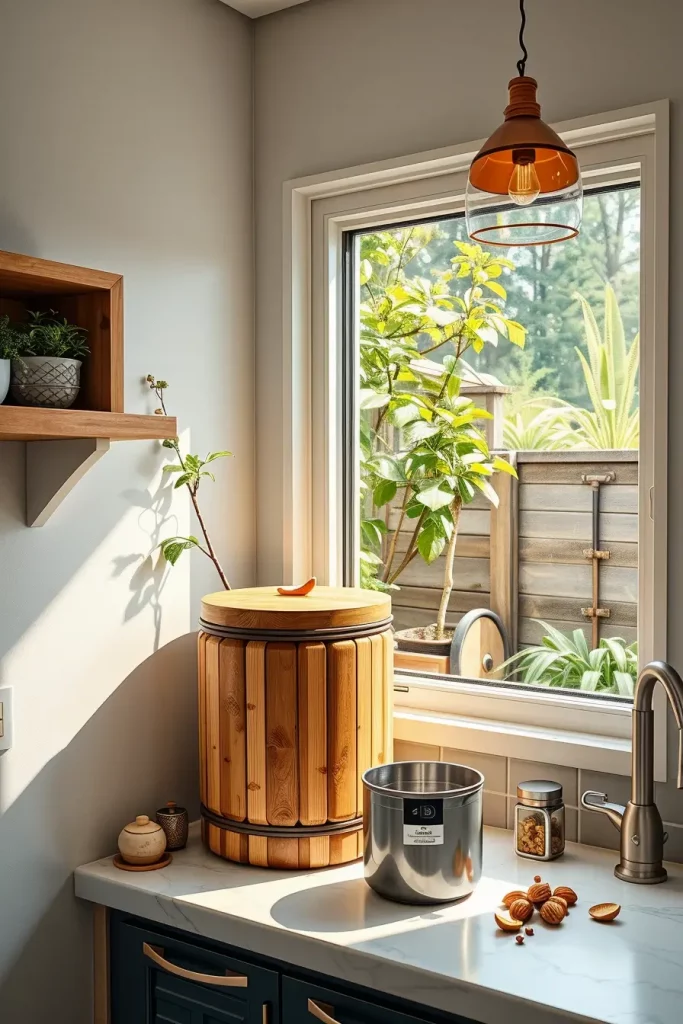
I would suggest smooth, odorless countertop compost bins to be used on a daily basis and large compost tumblers to be used by the family. Compost containers made of stainless steel or bamboo are very attractive with modern interior and at the same time are convenient in everyday life.
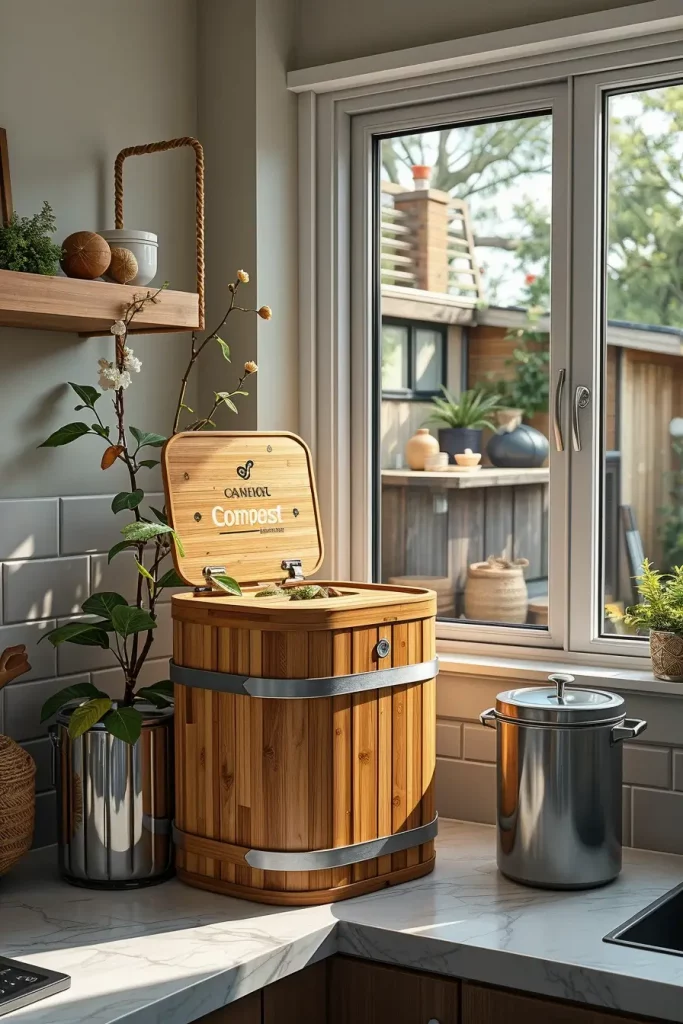
I have lived through the process of composting and the way it changes the rhythm of a house. Families are now more aware of food waste and gardens grow well when compost soil is added to them. The Environmental Protection Agency says that composting reduces the release of methane and contributes to the formation of healthier soil, which is one of the pillars of sustainable living.
To improve it, I would suggest that worm composting (vermicomposting) should be used instead, since it works especially well in small apartments or houses that lack an outlet.
Energy-Saving Appliances That Promote Green Living
No sustainable house can be complete without energy saving appliances. These save on electricity usage, utility bills and make day to day living easier. Contemporary designs make sure that environmentally friendly technology does not imply any performance sacrifice.
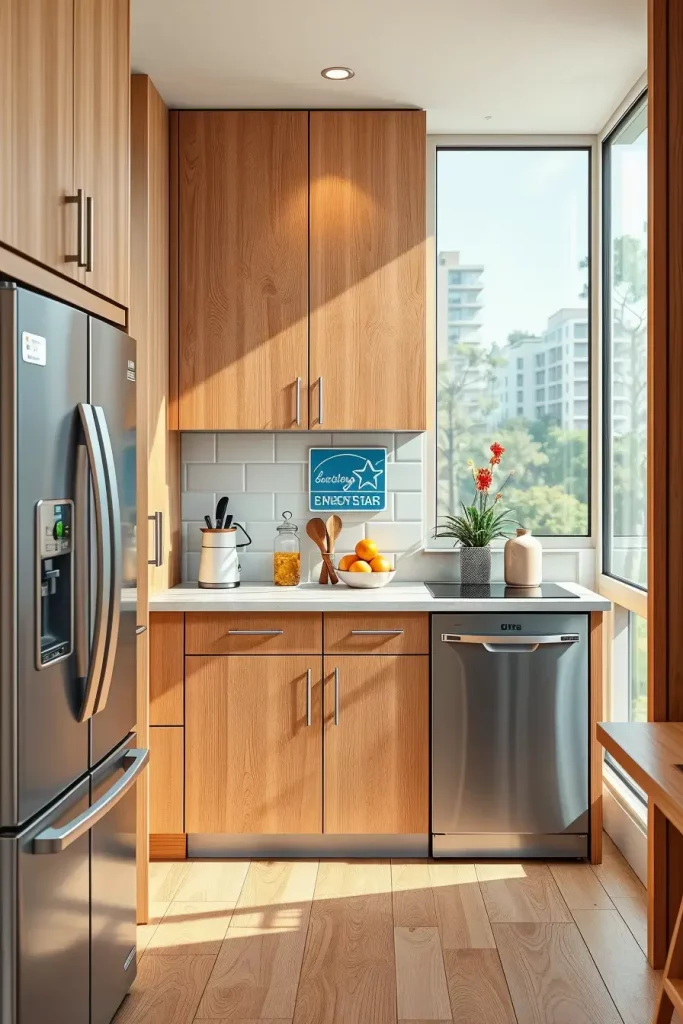
ENERGY STAR-rated refrigerators, dishwashers, and washing machines are the most efficient that I would recommend. Induction cooktops are also very welcome since they take less time to heat and consume less energy than the traditional stoves.
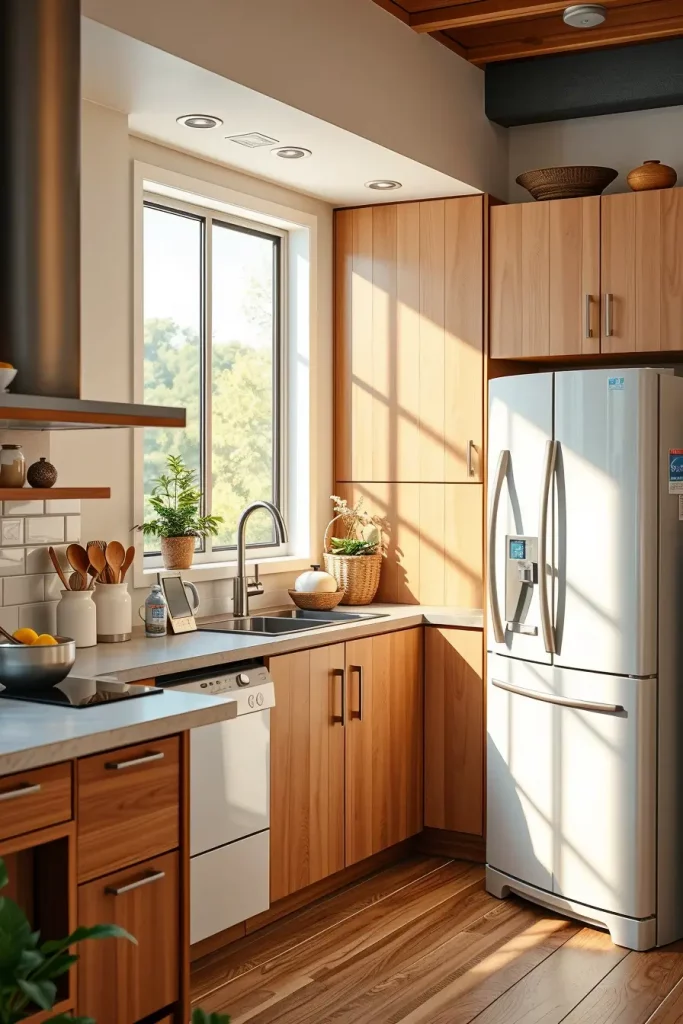
In my experience, clients are usually pleasantly surprised by the amount of money they save on bills in the first year of the upgrade. Consumer Reports also reported that a homeowner can save hundreds of dollars per year switching to energy-saving appliances without sacrificing any functionality.
I would also add smart appliances to this category because they enable the homeowner to track and regulate usage which also saves on unnecessary energy usage.
Solar Integration Sustainable Interiors
Solar integration is one of the most effective means to attain sustainability. It can be rooftop panels or interior solar-powered features, but using renewable energy makes a home entirely self-sufficient.
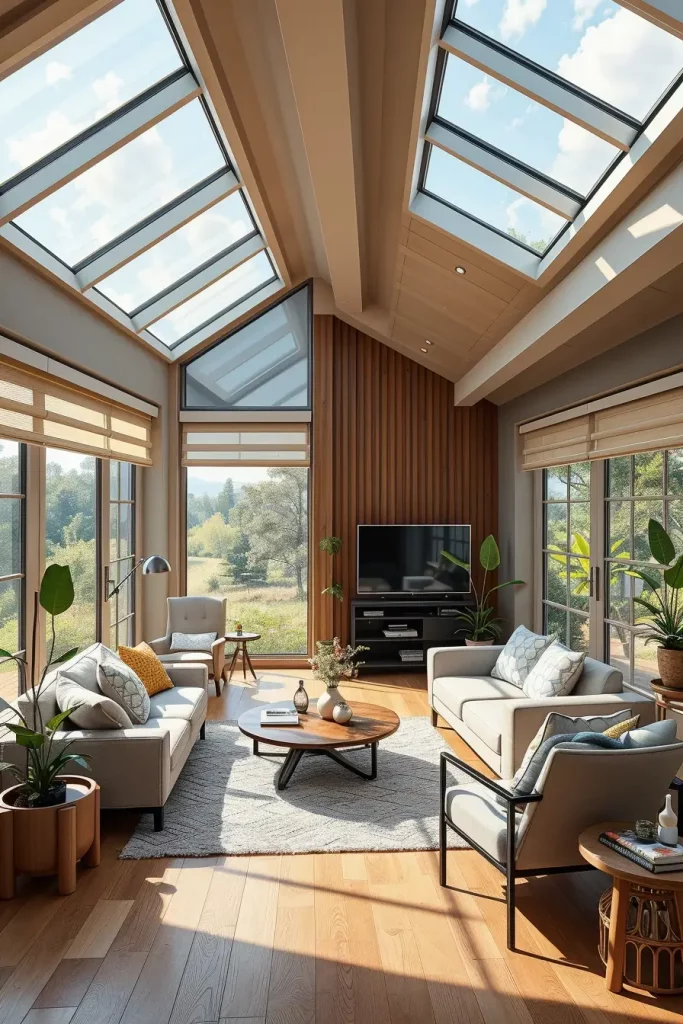
I would like to use solar-powered skylights, blinds, and charging stations in modern houses. Not only do they decrease reliance on grid electricity, but they also introduce something new and futuristic to the interior design.
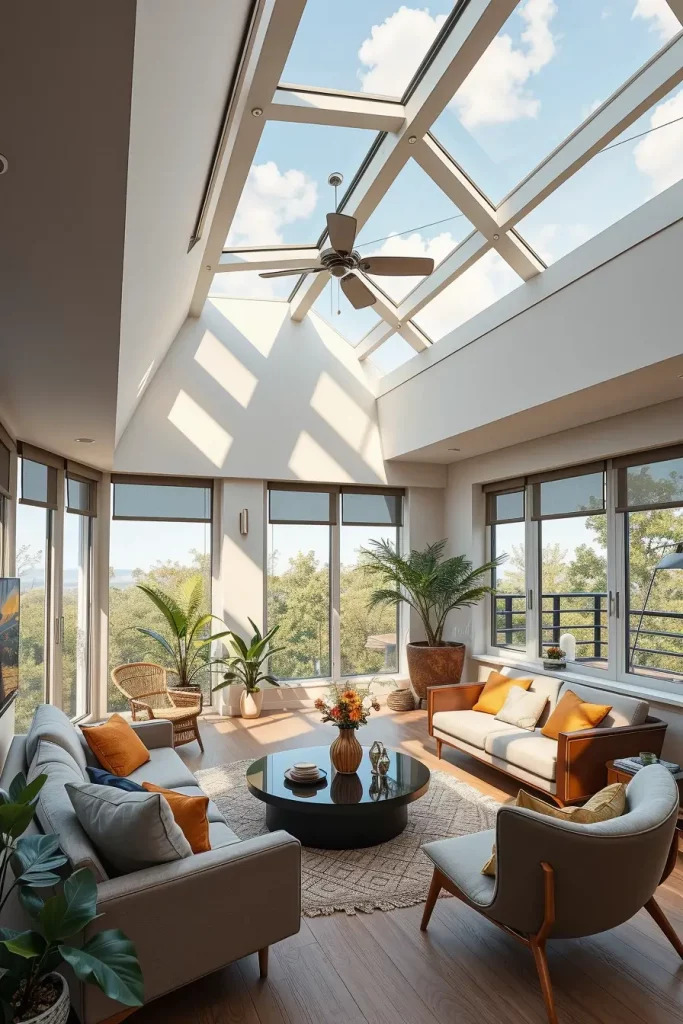
I believe that solar is a long-term investment that is economically and environmentally profitable. Most of my clients have saved a significant amount of money on their energy bills in a matter of years of installation. Architectural Digest has also pointed out the growing popularity of solar-powered interiors as an ideal way to live a modern, sustainable lifestyle.
To expand on this section I would add details about solar water heaters and in-floor heating systems which are quite effective ways of adding solar energy into our lives.
Minimalist Solutions To Decrease Wasteful Wastes
Minimalism is not just a style of aesthetics, but it is also a green lifestyle that is entirely congruent with sustainability. My minimalist values are to minimize waste, emphasize quality over quantity, and to be selective about the space.
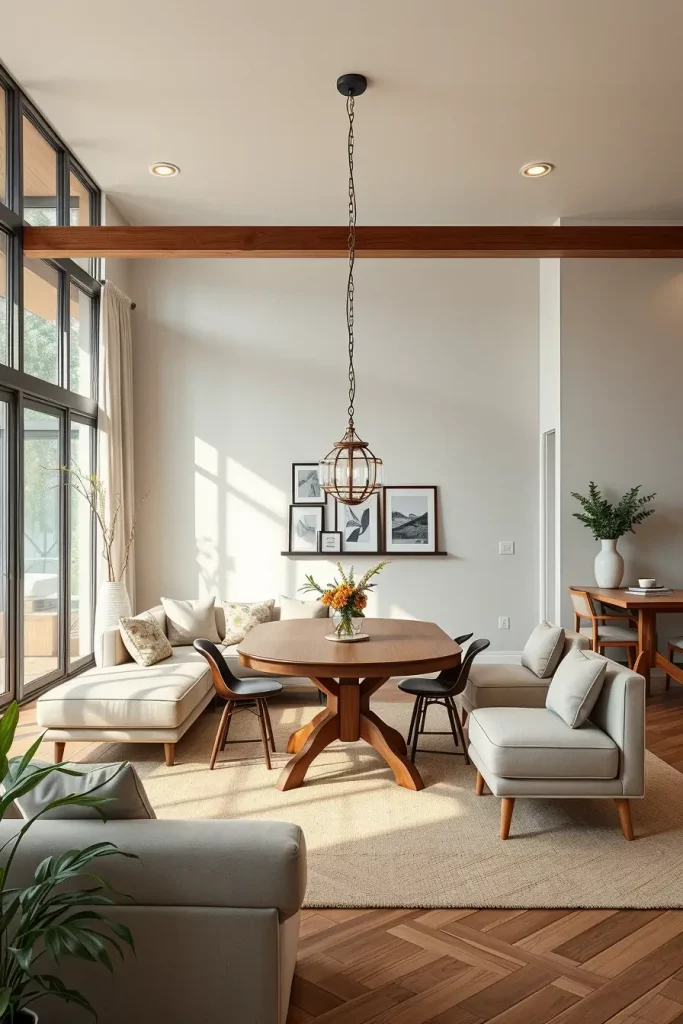
In the case of interiors, this can frequently imply the selection of multitask furnishings such as modular couches, extendable dining tables, or concealed storage beds. The few pieces selected are allowed to shine through neutral tones and natural materials.
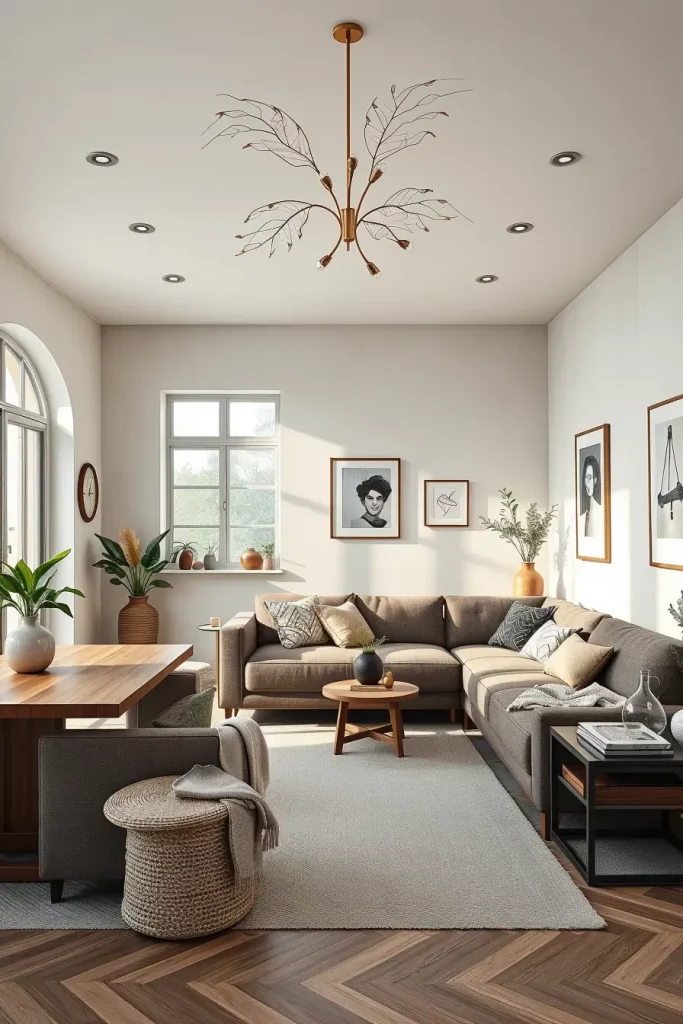
Personally, I think that minimalism makes us more conscious of what we buy. According to design guru Marie Kondo, only things that bring joy should be maintained not only as a way of decluttering but also as a way of living more sustainably. Clients have frequently reported to me that they feel more liberated and relaxed when they have simplified their interiors.
To complete this section I would include sustainable wall finishes such as limewash paint which adds to the minimalist look without being harmful to the environment.
Zero-Waste Storage And Organization Ideas
When people talk about sustainability, storage and organization are not commonly thought of, yet these are important in the zero-waste lifestyle. Smart systems help to make less clutter, resource reuse, and sustainable decisions a part of our daily life.
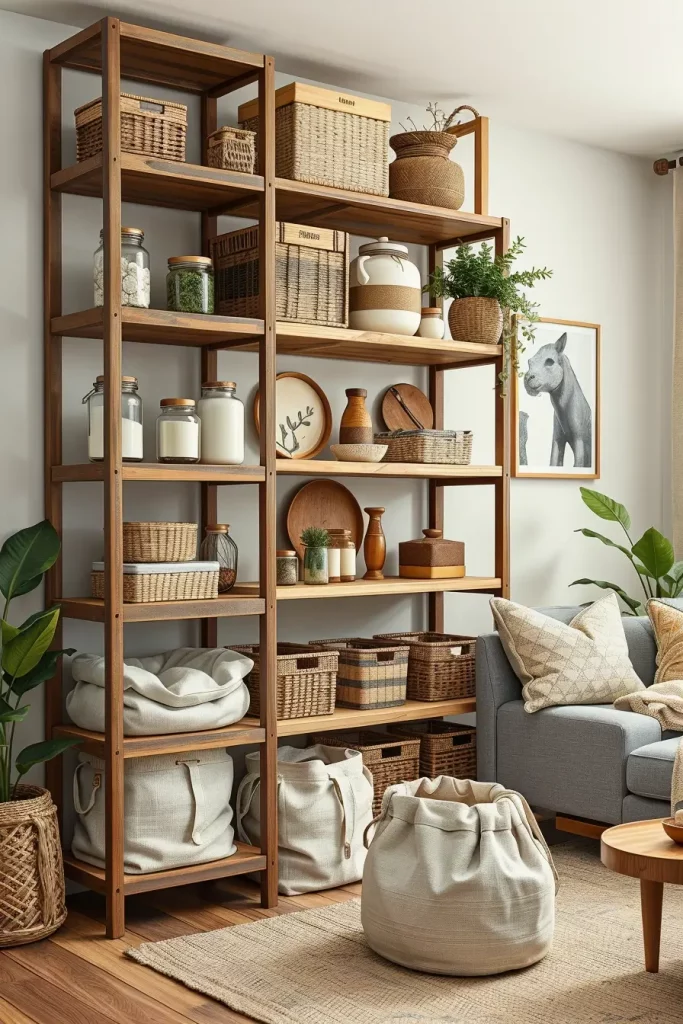
I tend to recommend glass jars, bamboo baskets, and recycled metal bins to store. Shelf units constructed using reclaimed wood are stylish and useful. I also prefer to use fabric bins that are made of organic cotton to store soft items in bedrooms or living rooms.
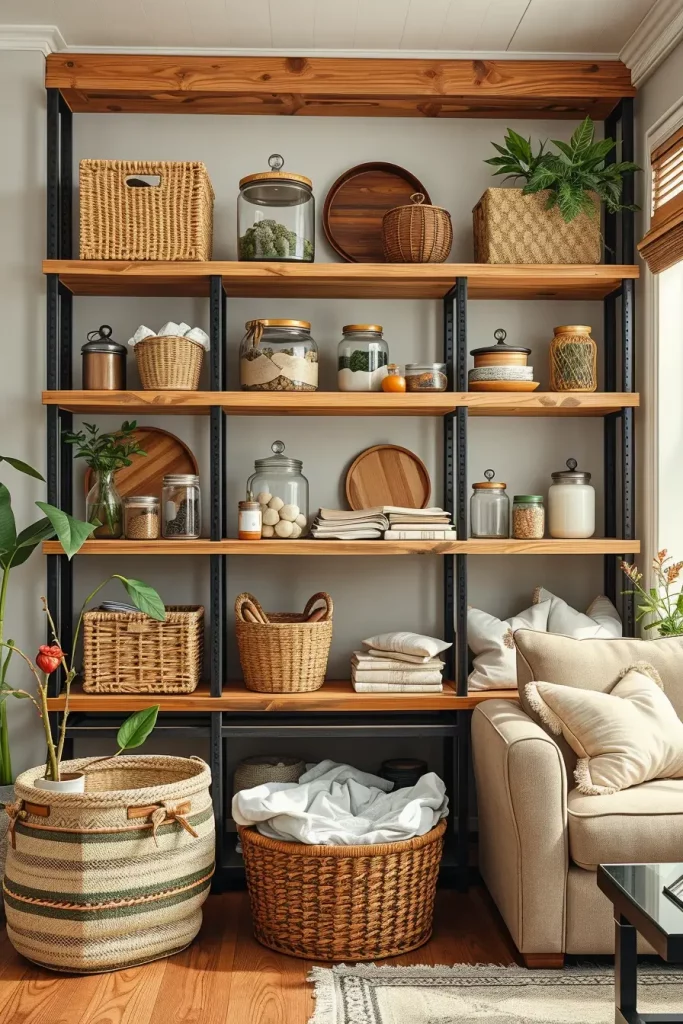
In my case, zero-waste organization helps to eliminate the desire to purchase additional plastic boxes that are not needed. Real Simple magazine reports that when people use zero-waste storage systems in their homes, their houses tend to be neater and more useful over the years.
To improve on this section I would include vertical storage systems which are recycled and are particularly useful in a small area with no effect on sustainability.
Green Home Office Design With Eco-Friendly Materials
As the number of people who are working at home increases, it has become necessary to develop a sustainable home office. I pay attention to eco materials that are comfortable and productive and have minimal impact on the environment.
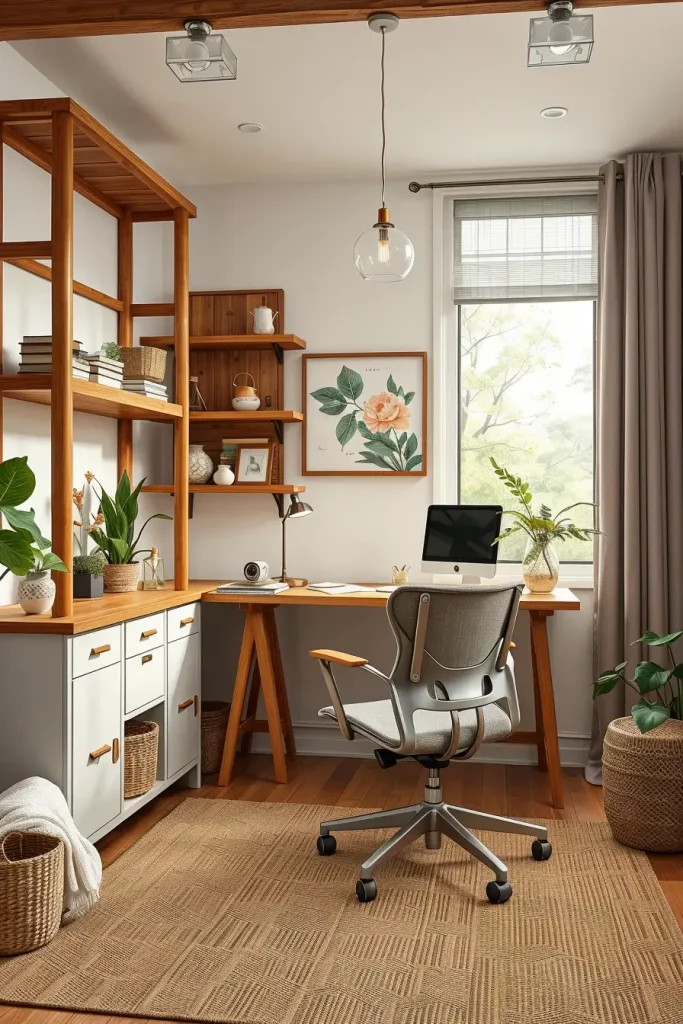
Some of my favorites include bamboo desks, reclaimed wood shelves, and ergonomic chairs that have organic fabrics on them. The arrangement is completed by natural fiber flooring, recycled glass office accessories, and LED task lighting.
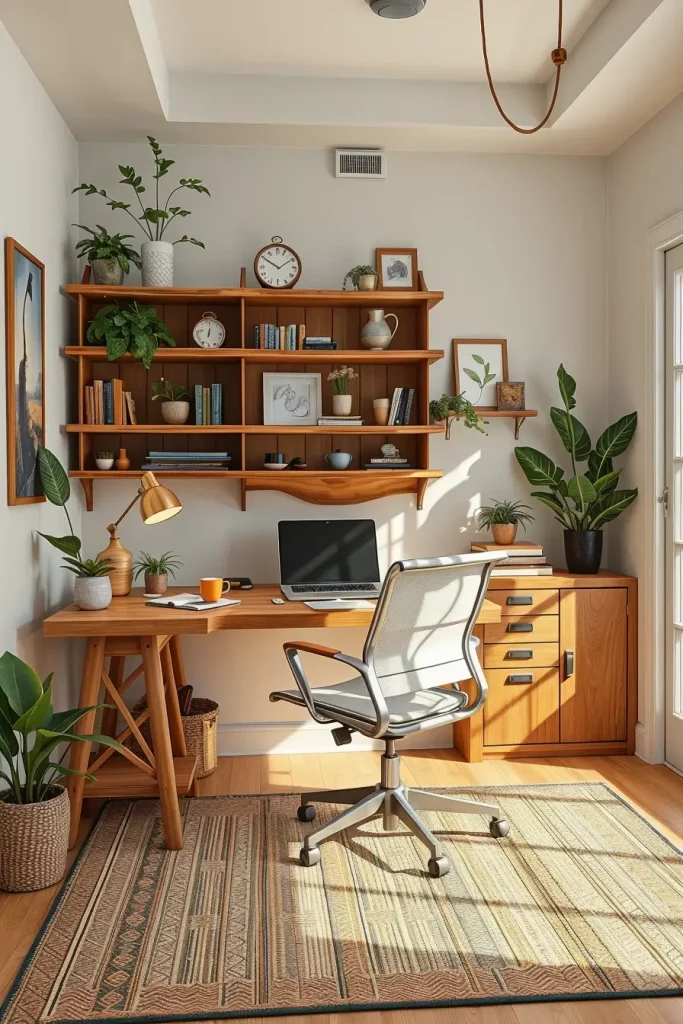
On a personal level I have also learned that a sustainable home office is not only greener, but also more focused. The combination of natural materials and integration with daylight will provide a relaxing and motivating environment, which Forbes has noted as an increasing trend in remote work design.
As a better way of doing things, I would suggest that we should embrace energy efficient electronics like long battery life laptops or smart power strips that use less phantom energy when the devices are not in use.
Children’s Rooms With Green And Safe Decor
Safety and health are the first things that come to mind when I consider sustainable design of the children rooms. The atmosphere will be safe and friendly with the help of non-toxic paint, FSC-certified wood, and organic cotton bedding. These rooms need natural light combined with energy saving LED lights. Storage constructed of recycled or reclaimed materials is a frequent recommendation of mine because the rooms of children are likely to require organization solutions that expand as they do.
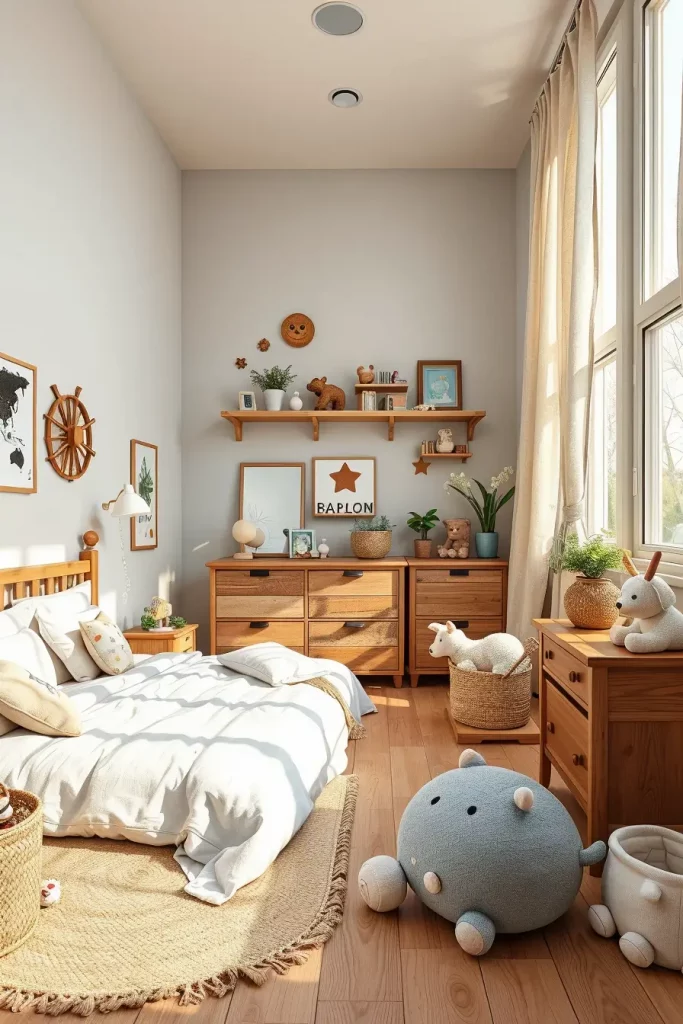
With furniture, I would choose modular furniture such as adjustable desks and convertible cribs that can be changed as the child expands. Reclaimed wood dressers, organic wool carpeting and bamboo shelving are strong, beautiful and still environmentally friendly. These works are timeless, so they will not have to be changed every few years and will not waste as much, preserving a fashionable appearance.
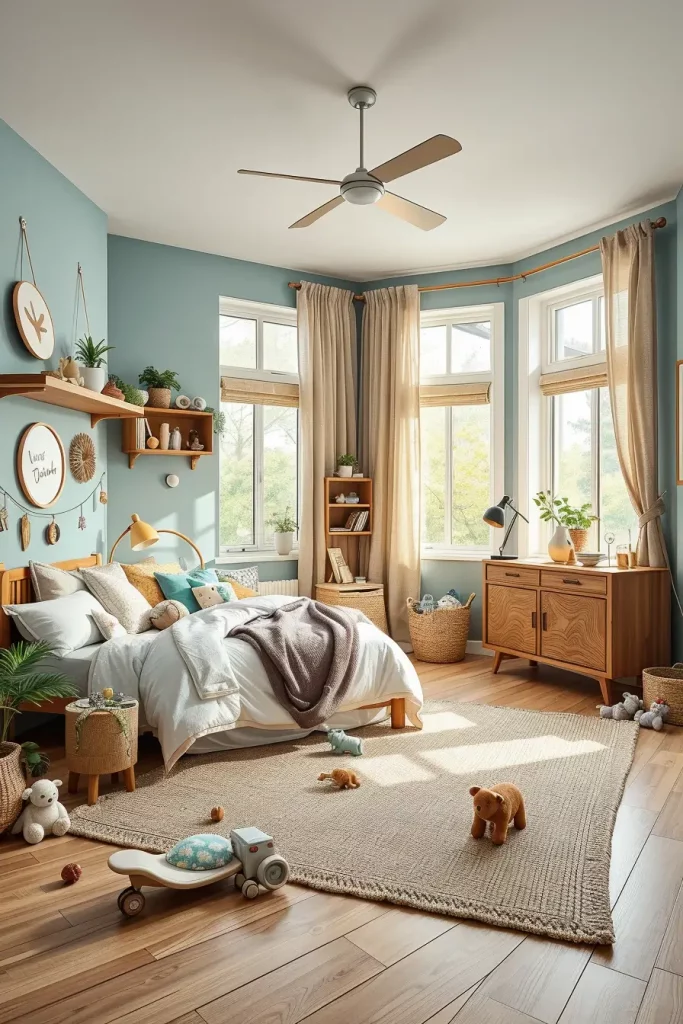
In my case, parents would be pleased to know that their children have a safe room as well as one that is benefiting the planet. Even celebrity interior designers such as Nate Berkus have stressed that kid-safe materials in kid spaces are as important to appearance as they are to long-term health. I could not have said better–it is a matter of building a calm atmosphere that develops with the child.
I would also include blackout curtains of organic linen to regulate natural lighting to enhance sleep patterns. This is something that is usually ignored, yet it makes the experience much more comfortable and functional.
Designing Outdoor-Indoor Flow in an Eco-Friendly Way
Smooth transitions between the indoor and outdoor environment are one of the most effective sustainable home interior decorating concepts. The lines between the two are blurred by large glass doors, reclaimed wood flooring that leads to a patio, and indoor plants. This maximises natural light and also minimises artificial cooling or heating when designed well.
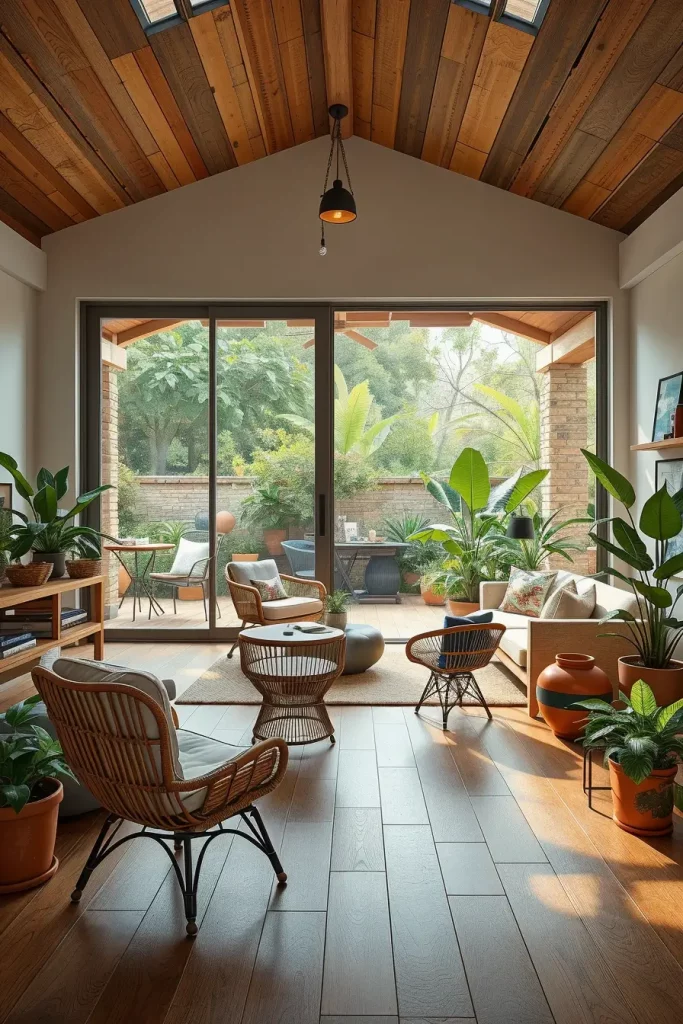
In the case of furniture, I prefer combining indoor furniture of rattan, bamboo or recycled metal that can withstand the indoor and outdoor environment. Dining tables made of reclaimed wood and placed close to sliding glass doors with eco-friendly seating promote fluid living. Plants that conserve water in clay pots also make the air clean and fresh.
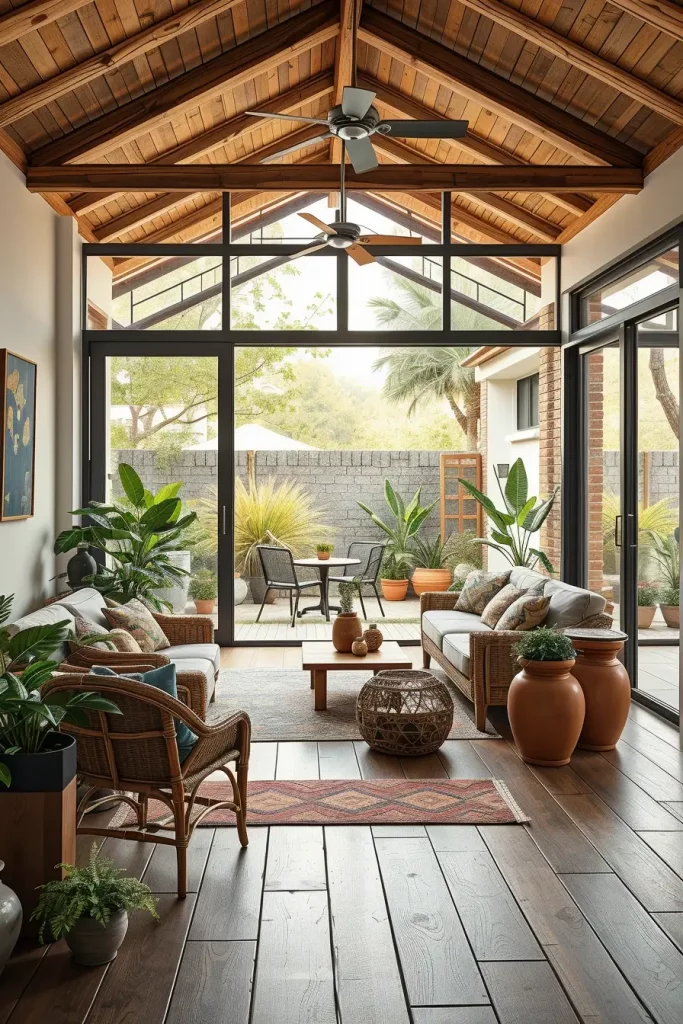
I have observed in my own projects how much more comfortable a home can be when the connection between the indoors and outdoors is carefully considered. Other magazines such as Architectural Digest will be more likely to show how the trend is sustainable and improves the standards of living. I would advise homeowners to use high quality doors and windows that have low-E glass to save energy.
The only thing that is usually lacking in this case is the greenery and utility. The transition can be even smoother by adding vertical gardens or wall planters with native plants inside, and less artificial decor will be needed.
Seasonal Decor With Reusable And Natural Elements
Seasonal changes can be tricky when it comes to decor but you do not want to waste money. I would always suggest that clients should use natural materials such as pinecones, dried flowers, gourds or branches rather than single-use plastic decorations. They are friendly and natural and do not damage the environment.
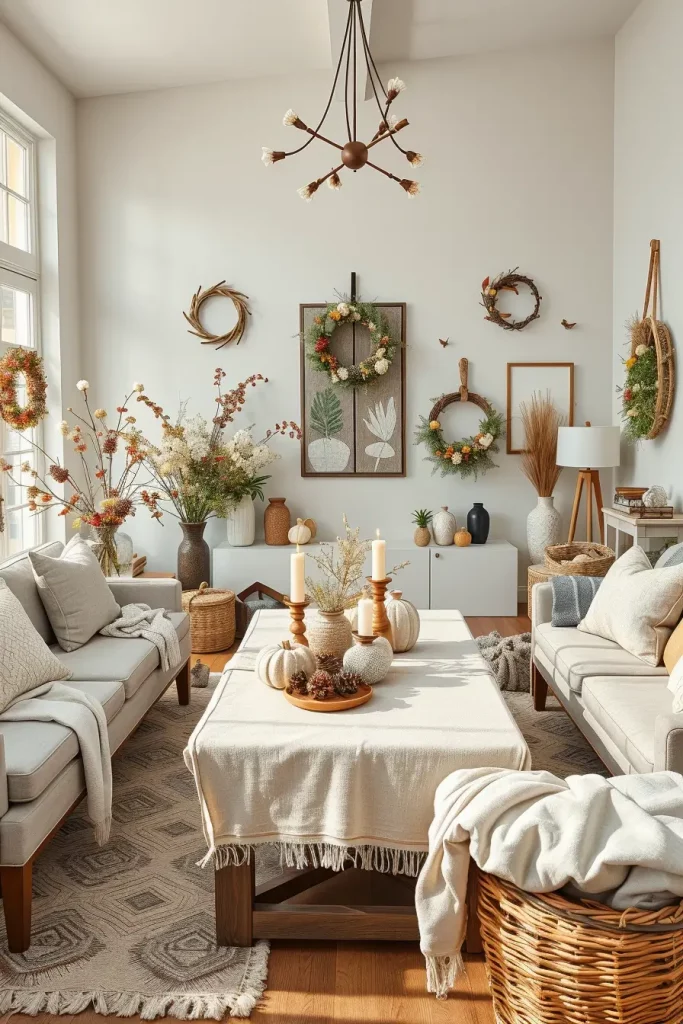
Organic cotton throws or linen table runners are nice seasonal accents and can be reused. Rather than purchasing new decor every season, I would recommend purchasing neutral-colored objects that are timeless and then adding nature-inspired accents. Wooden candle holders, ceramic vases and handwoven baskets are great additions that can remain throughout the year.
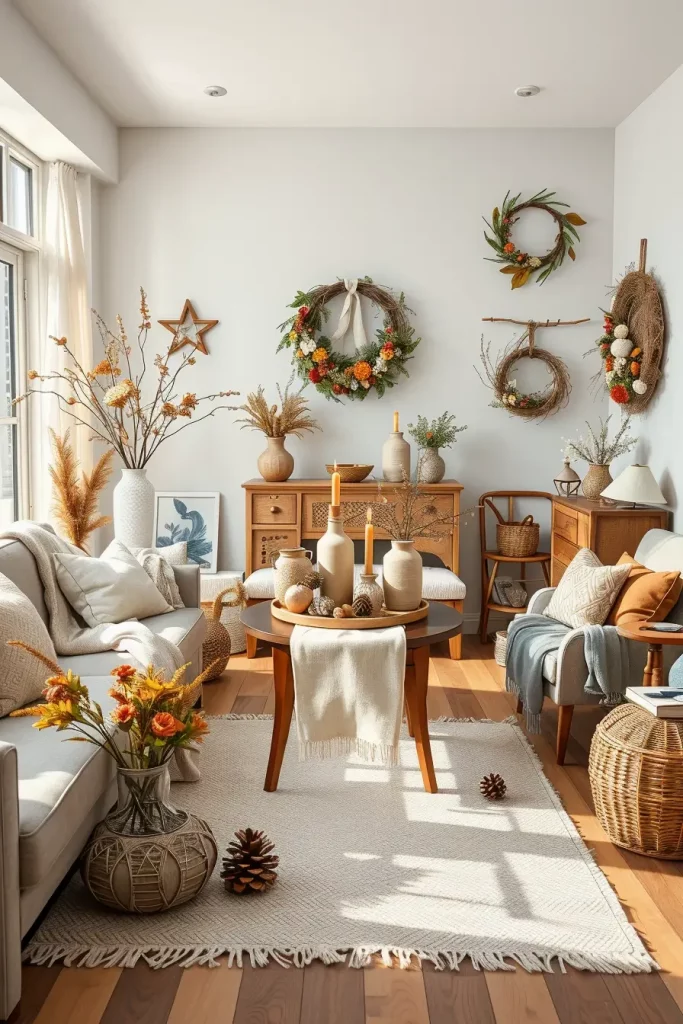
Personally, I am fond of using natural garlands or wreaths to decorate. They can be used and composted and are much more sustainable than synthetic options. Design gurus such as Joanna Gaines have frequently indicated that seasonal decor does not need to be temporary–it can be a natural part of your house with the appropriate natural accents.
To make it even more sustainable and to improve the atmosphere I would incorporate compost-friendly seasonal products such as beeswax candles or dried fruit garlands. These add comfort without unnecessary clutter and waste.
The Future Of Sustainable Home Interiors: Trends To Be Watched
Sustainable home interiors have a bright future. Smart lighting systems, furniture composed of mushroom mycelium, and 3D-printed objects created with recycled plastic are transforming the way we approach the concept of eco-friendly living. There will be more and more homes that incorporate renewable energy and biodegradable materials.
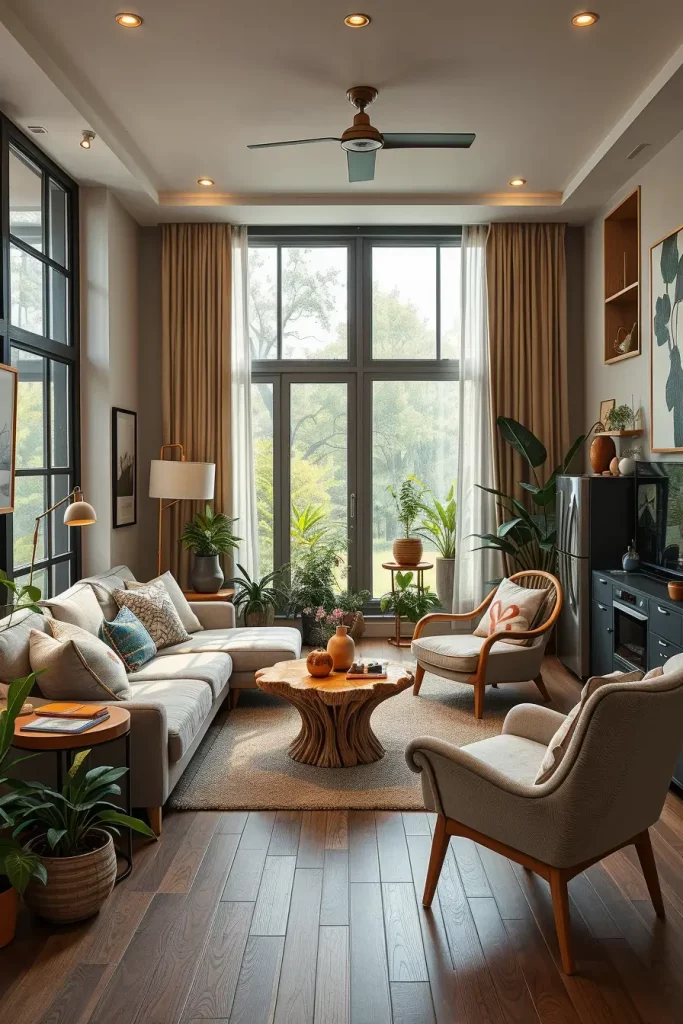
In the case of interiors, I can imagine that furniture with the principles of the circular economy will gain popularity. Disassemblable pieces (i.e. pieces that can be disassembled to replace parts or recycle them) will soon take over the market. Similarly, recycled water bottle fabrics or hemp fabrics will increase upholstery and bedding choices.
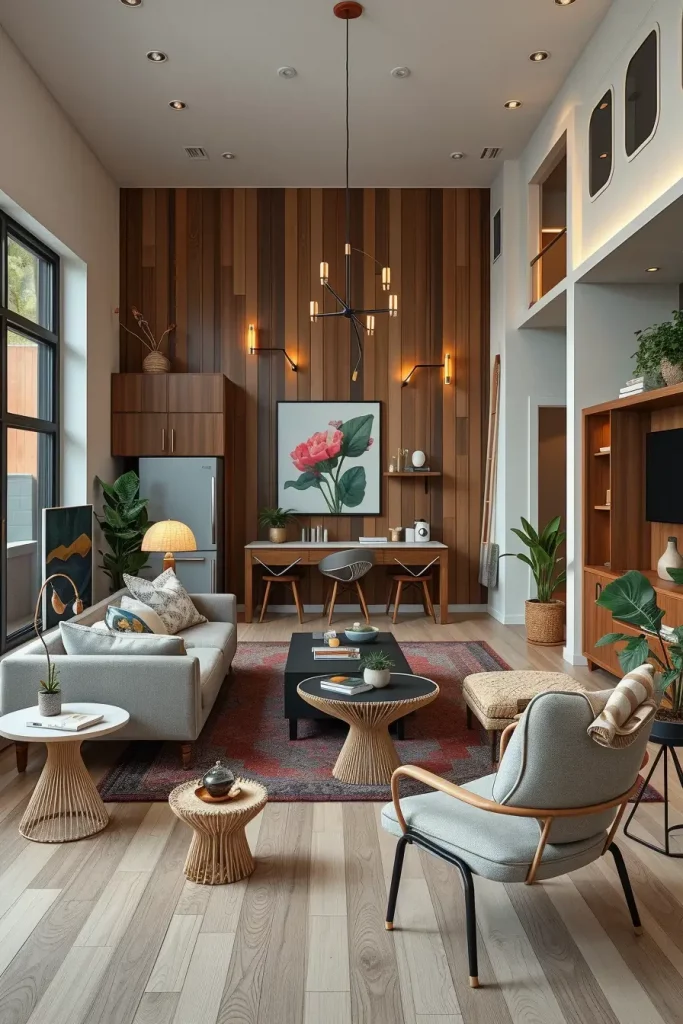
In my opinion, this development is not only a question of eco-consciousness, but also a question of style and comfort. As Elle Decor recently pointed out, sustainability and style are no longer in conflict, they go hand in hand. I am sure homeowners will love the way these inventions enable them to customize their homes without feeling guilty.
I would suggest the installation of high-tech energy-saving devices and home automation that checks water and electricity consumption. This is the coating that is missing and makes houses beautiful, efficient and environmental friendly.
Sustainable interior decorating of the home is not only about style, but also making conscious decisions that can enhance our quality of life without harming the planet. Since our environment is eco-friendly and our materials are reused, all of our design and decor choices can be long-lasting. We create not only beautiful homes with these concepts, but also healthier and more responsible homes. What are some of the sustainable options that you have already experimented with at home? Comment below about your experiences–I would like to know what you have to say!
